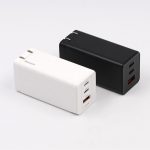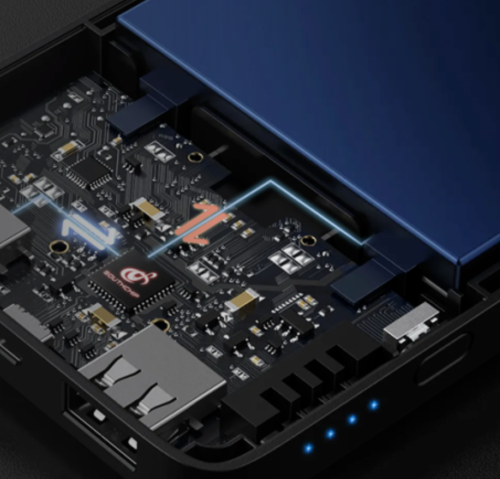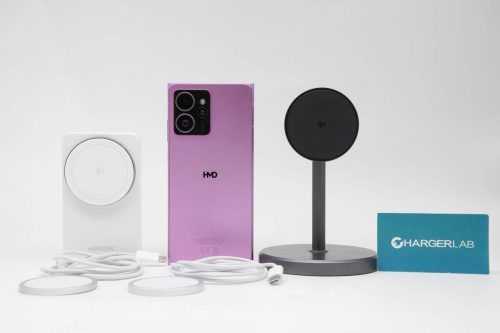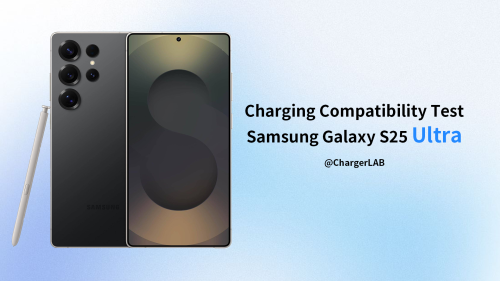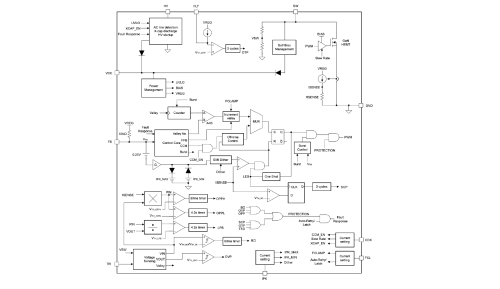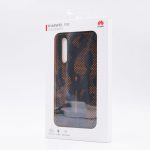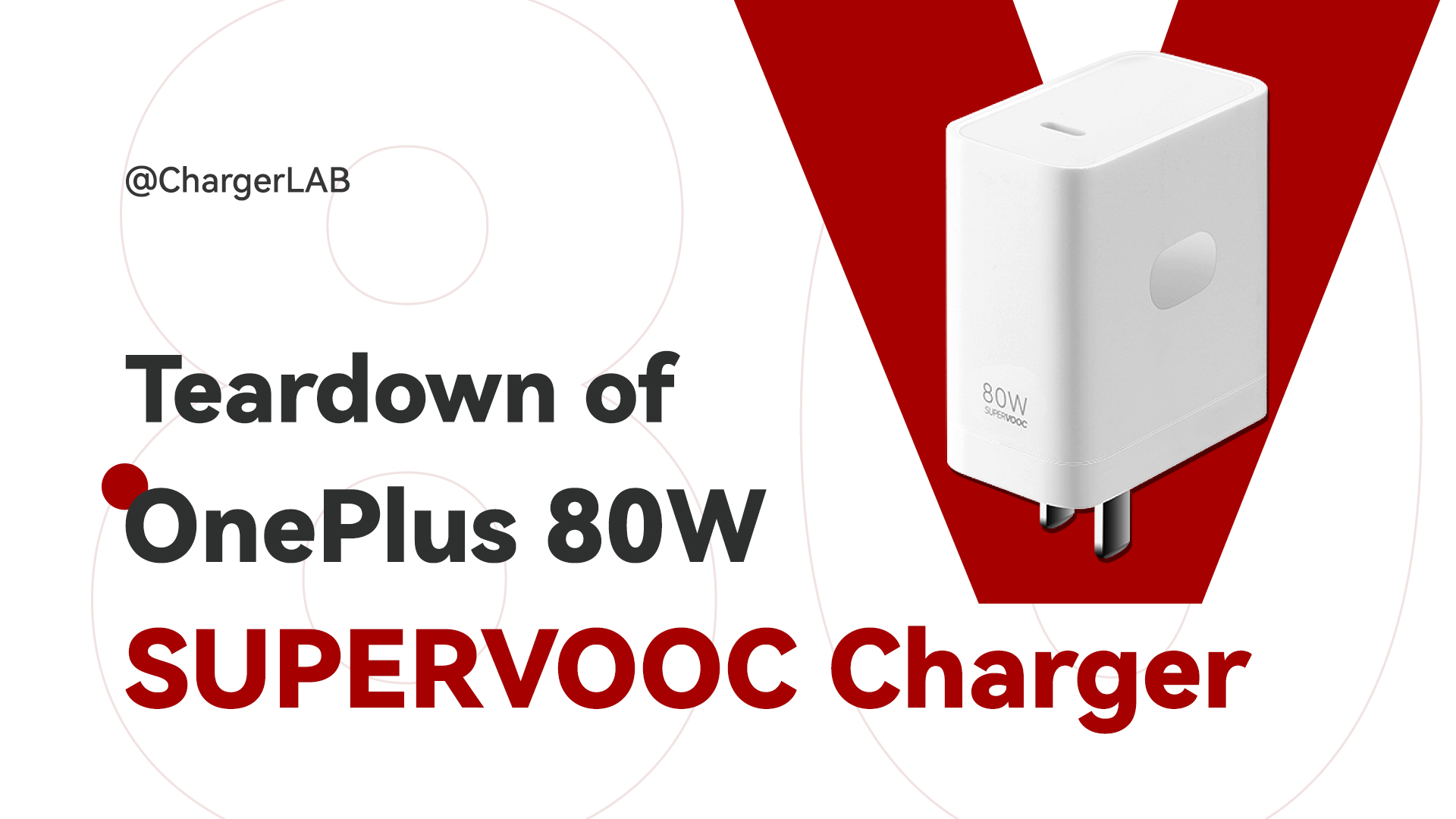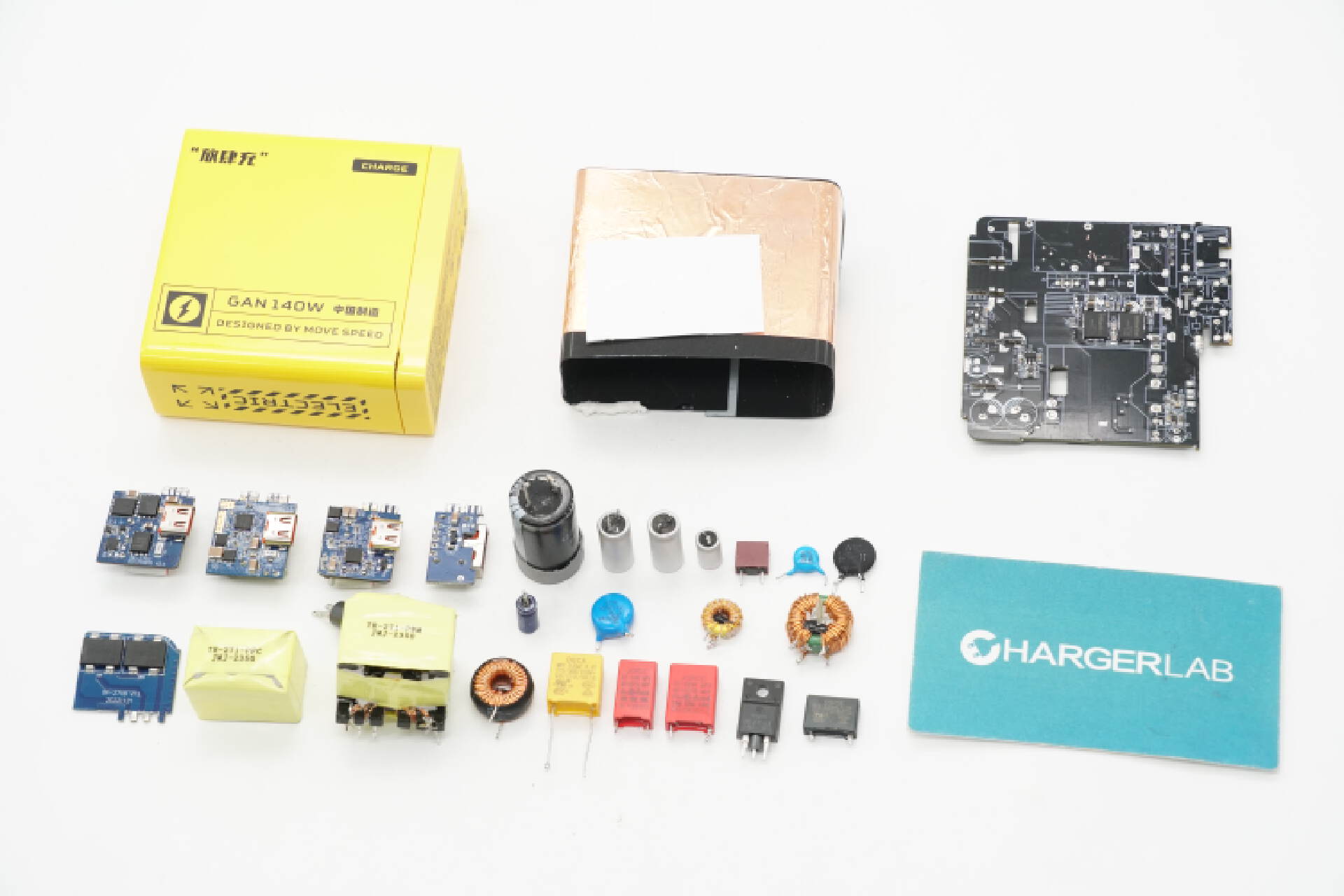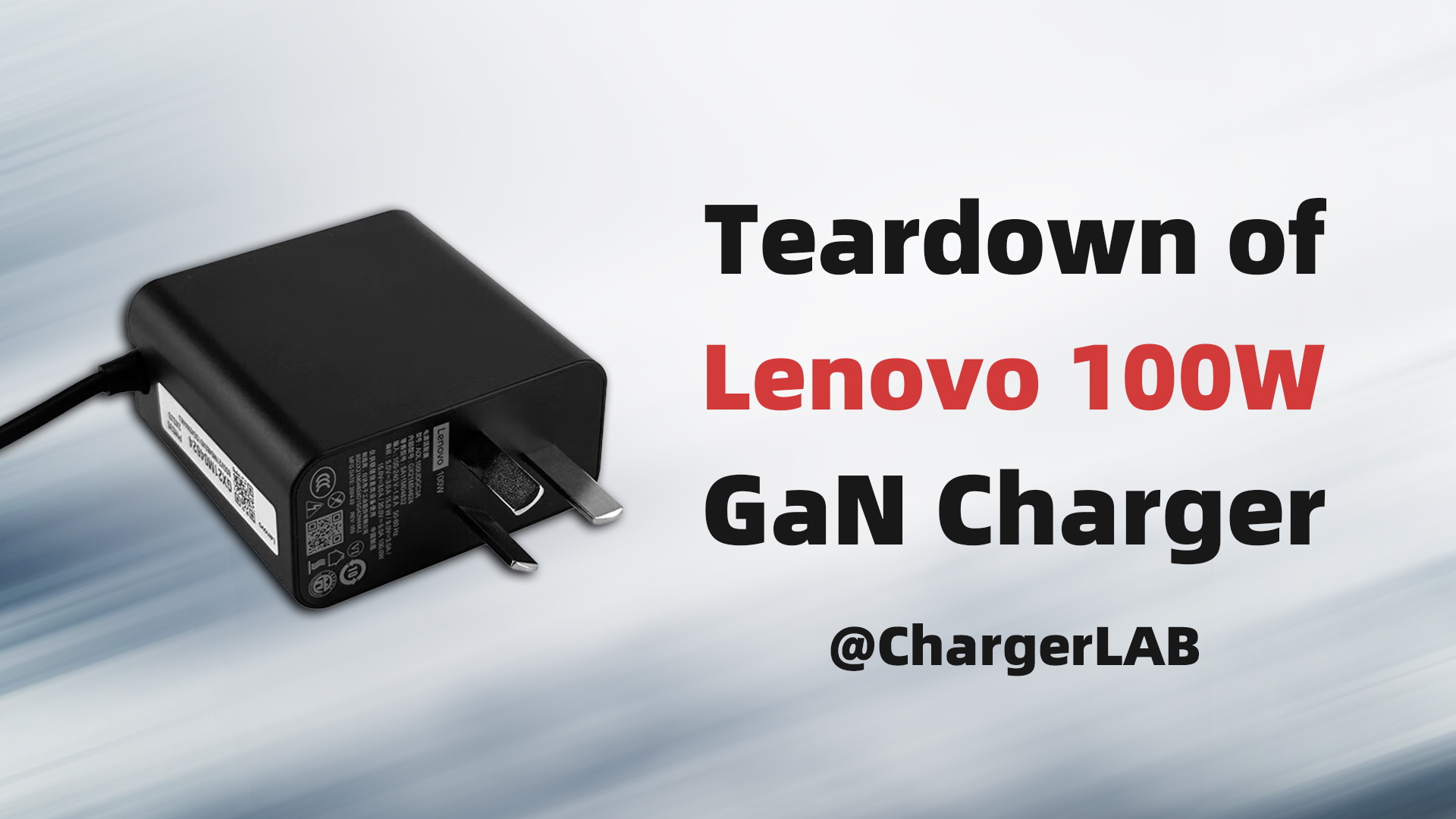We did an exclusive hands-on of the world's first 2C1A multiport GaN charger - the Baseus 65W 2C1A multiport GaN charger, few weeks ago, which was unveiled at a special event in Shenzhen, China, on August 18. The charger has foldable prongs and an LED indicator on the side. It will be available in mainland China starting in early September.
It is based on GaNFast solution from Navitas which enables high wattage inside an ultra compact form factor. It also makes the first debut of GaNFast on a multiport charger (the RAVPower 45W Ultrathin and AUKEY 27W PA-Y19 are single port chargers based on GaNFast). GaN, or Gallium Nitride, which is a new type of semiconductor material that offers higher efficiency, higher thermal conductivity, higher temperature resistance, and other advantages than traditional silicon. When it comes to charging, GaN can greatly reduce the size and boost the efficiency of a charger.
Here's our teardown review of the Baseus 65W 2C1A multiport GaN charger.
I Unboxing
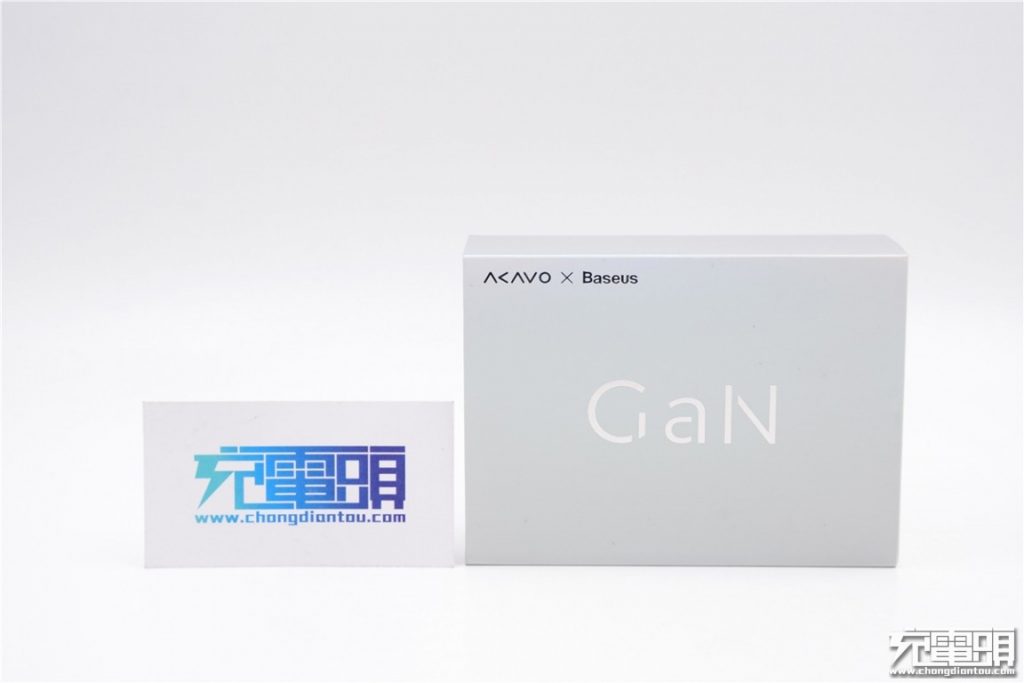
A sleek packaging in silver. Note that in China, the charger is a collaboration between two brands: Akavo and Baseus. The product is released first by Akavo.

The packaging is well-considered with a foam to protect the charger.
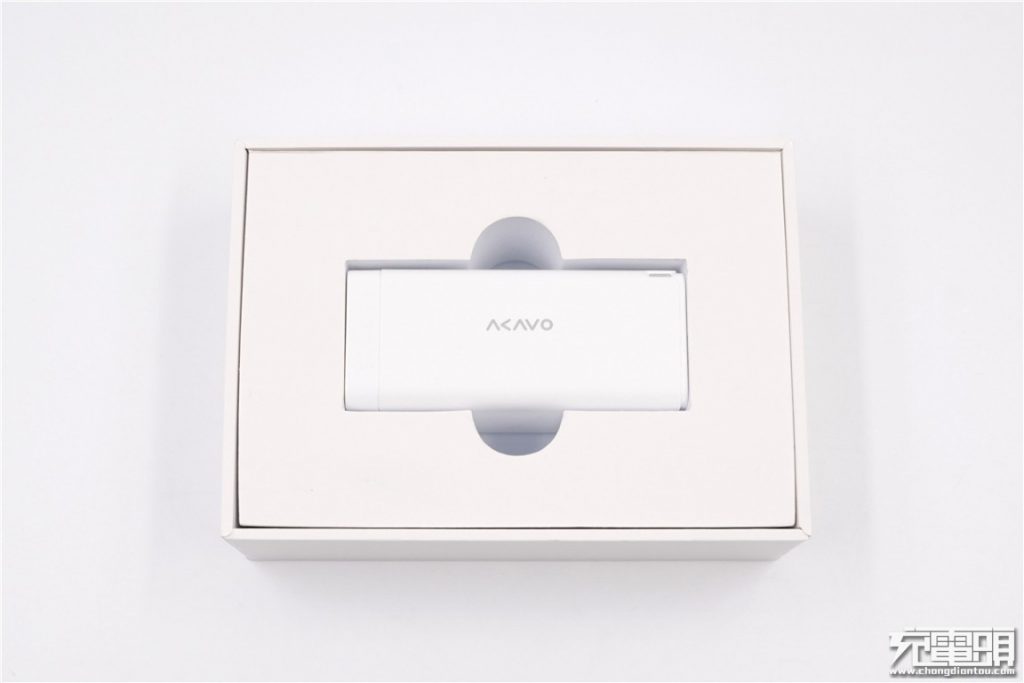
Akavo logo on the charger.
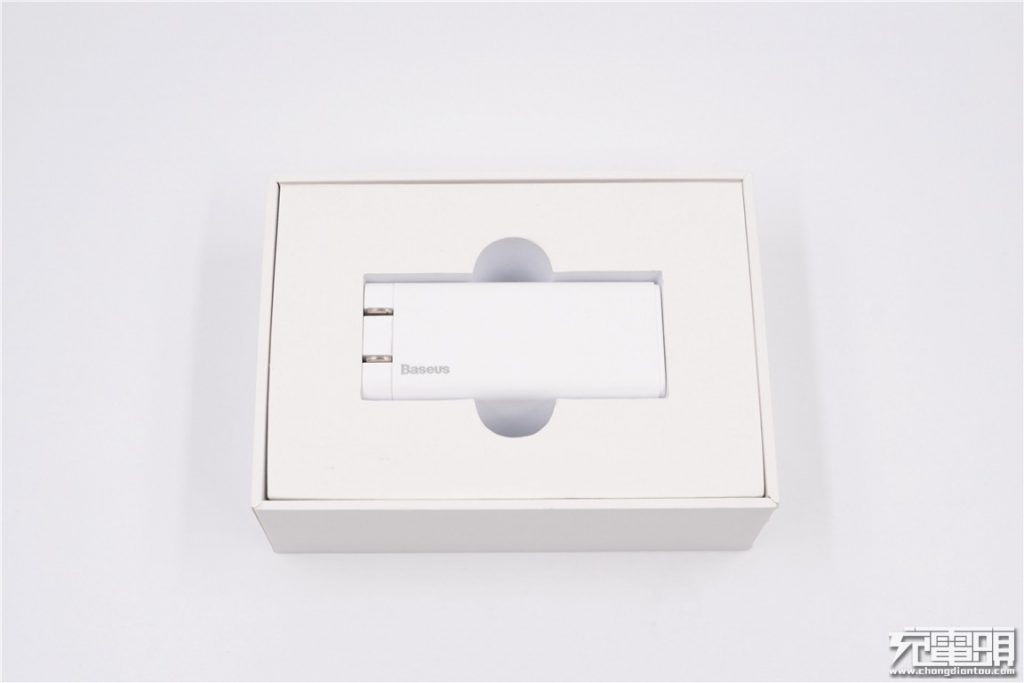
Baseus logo on the other side.
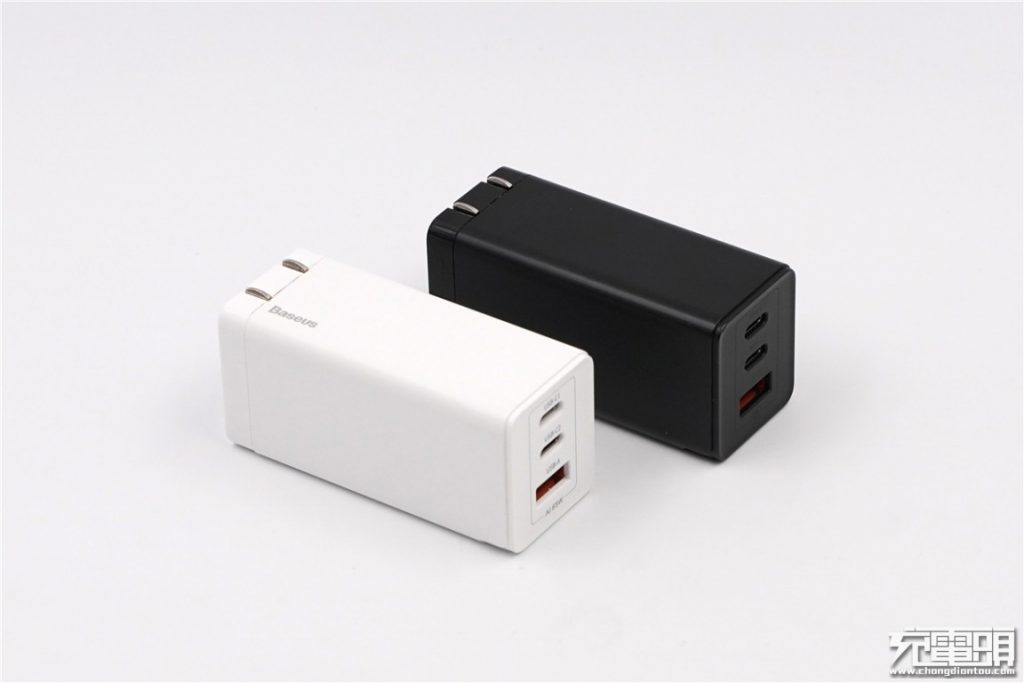
Two color options: white and black.
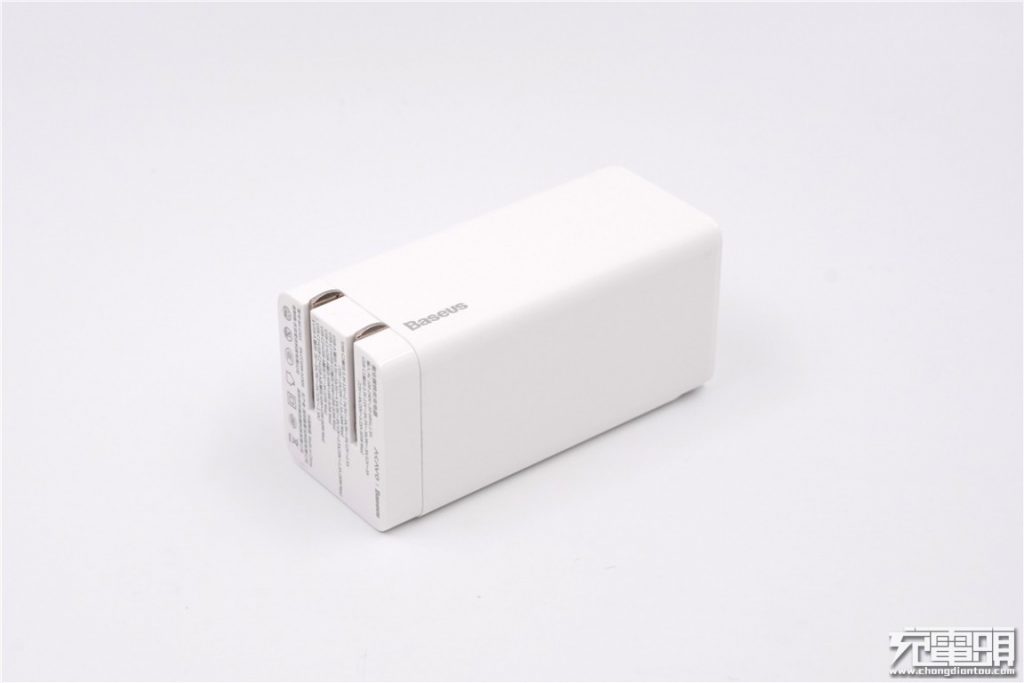
The charger is made of PC material with a matt finish. The overall shape is slender with rounded sides for better hand-feel. The prongs are foldable.
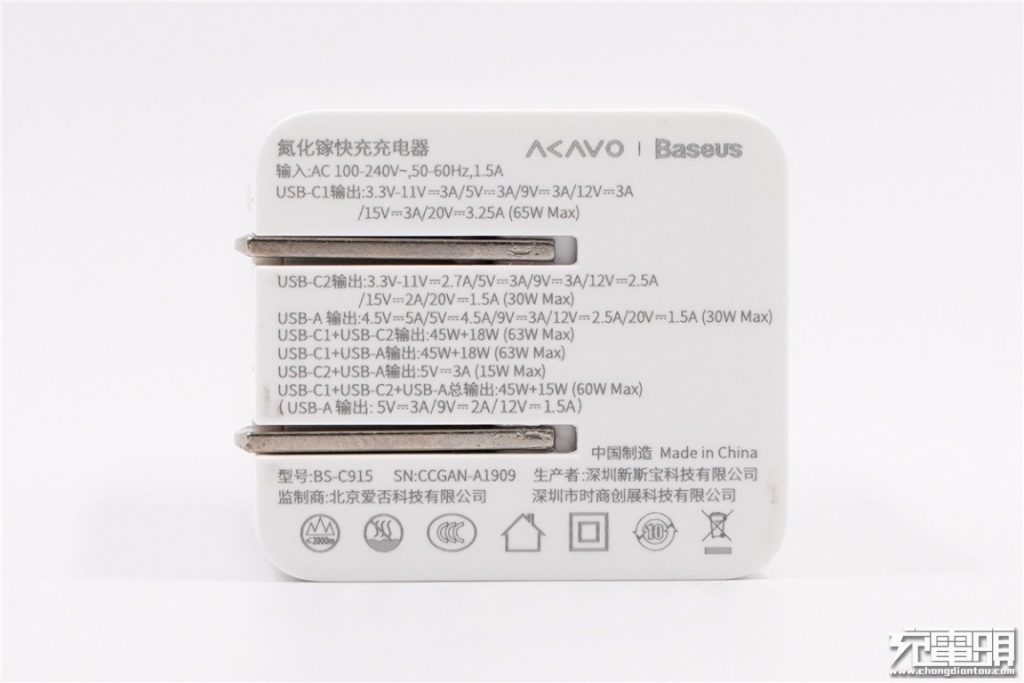
Specifications:
Model: BS-C915
Input: AC 100-240V~, 50~60Hz, 1.5A
USB-C1 Output: 3.3V-11V/3A, 5V/3A, 9V/3A, 12V/3A, 15V/3A, 20V/3.25A Max
USB-C2 Output: 3.3V-11V/2.7A, 5V/3A, 9V/3A, 12V/2.5A, 15V/2A, 20V/1.5A Max
USB-A Output: 4.5V/5A, 5V/4.5A, 9V/3A, 12V/2.5A, 20V/1.5A
USB-C1+USB-C2 Output: 45W+18W (63W)
USB-C1+USB-A Output: 45W+18W (63W)
USB-C2+USB-A Output: 5V/3A
USB-C1+USB-C2+USB-A Output: 45W+15W (60W)
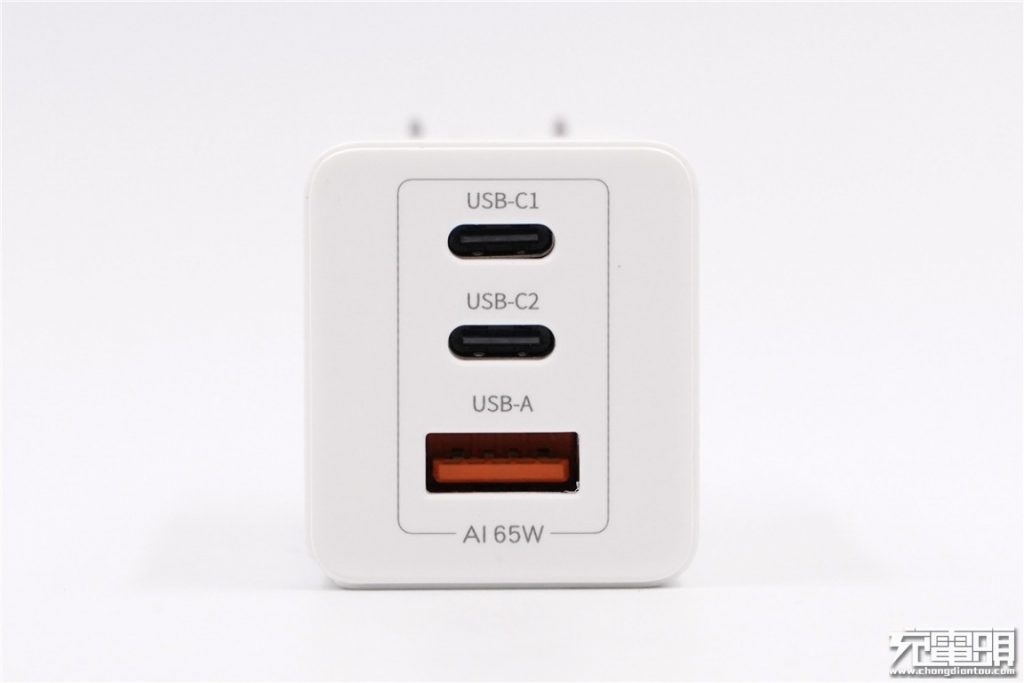
Two USB-C ports on top, below is a USB-A port.
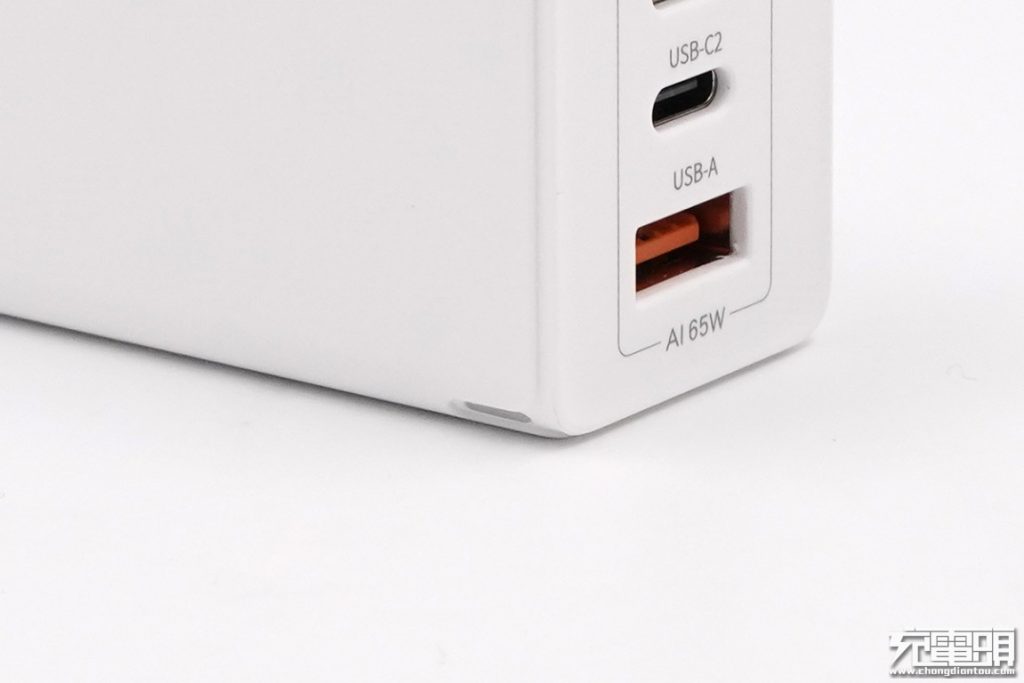
An LED indicator in the corner.
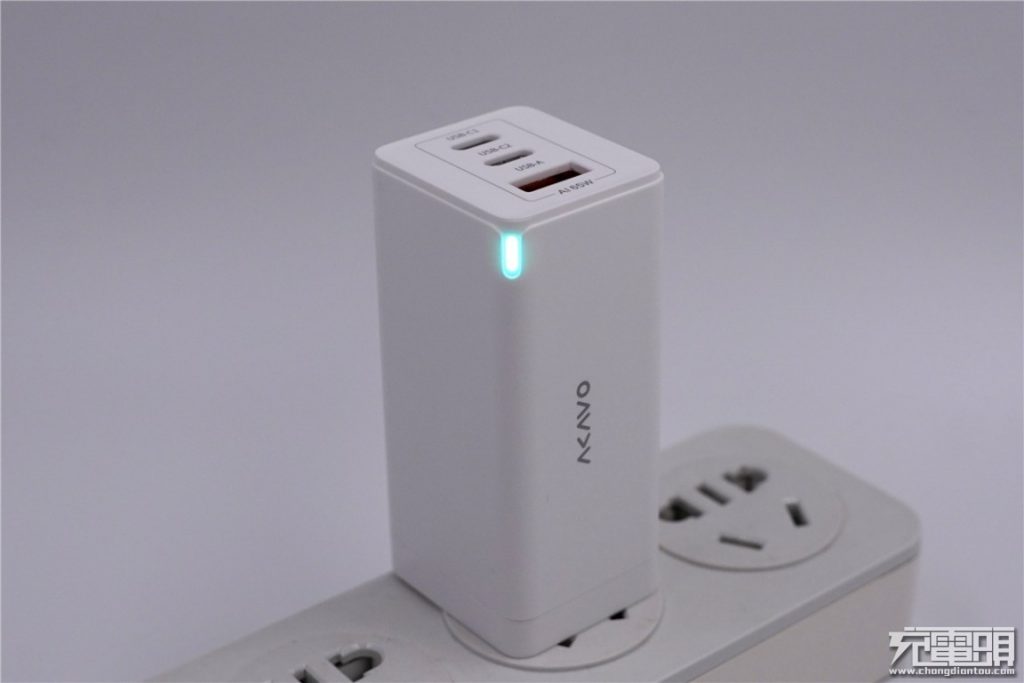
The LED indicator has a very nice icy green color.
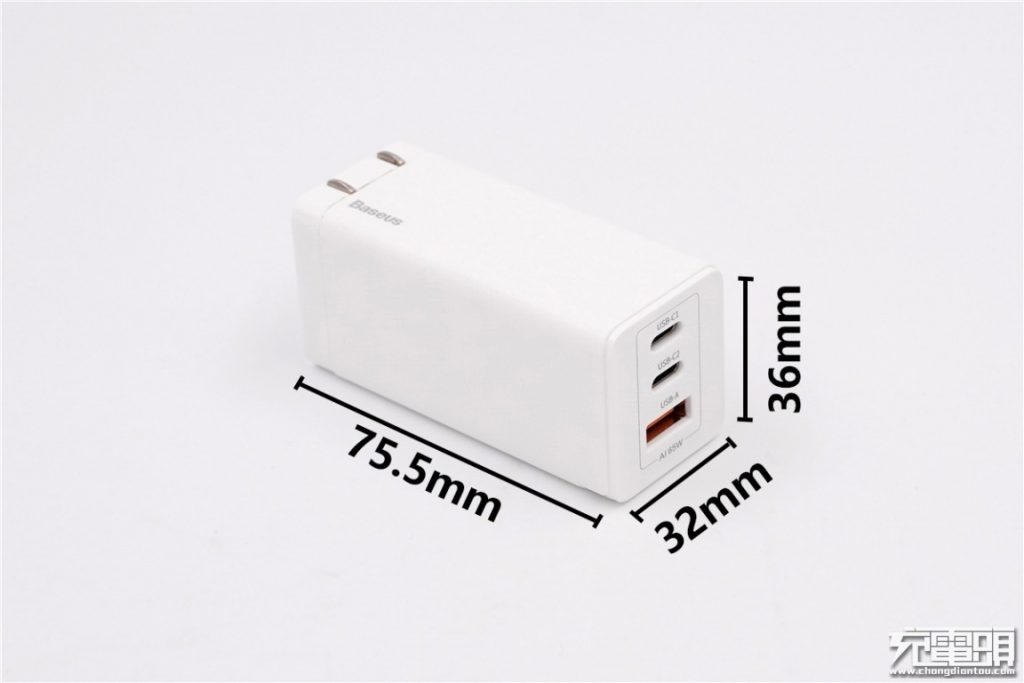
Dimensions: 75.5x36x32mm (3.0×1.4×1.3in).
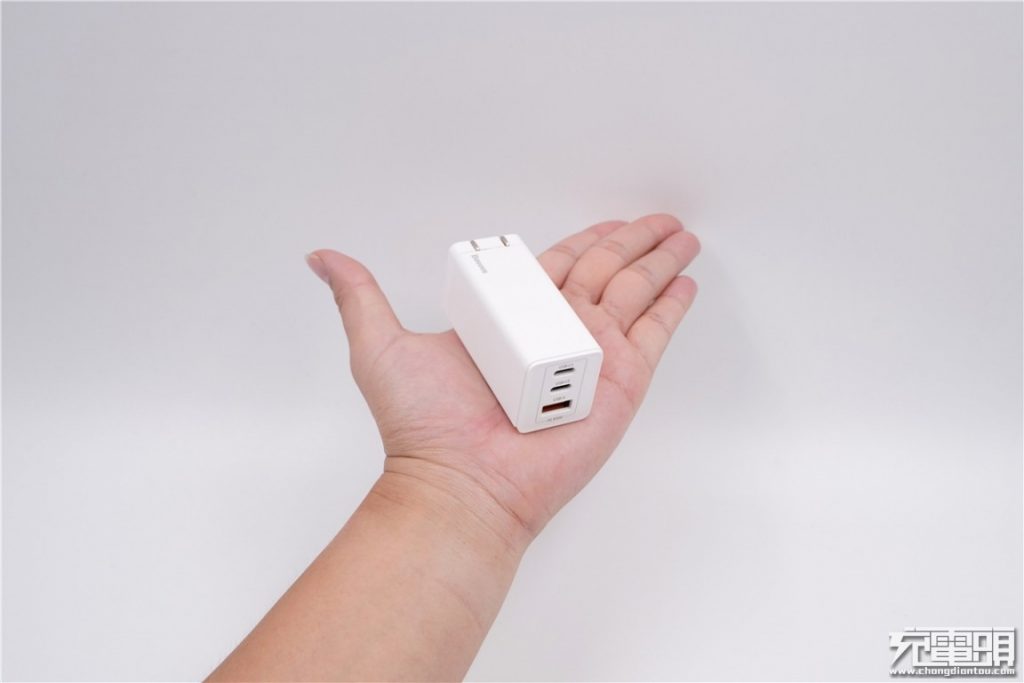
Vey compact.
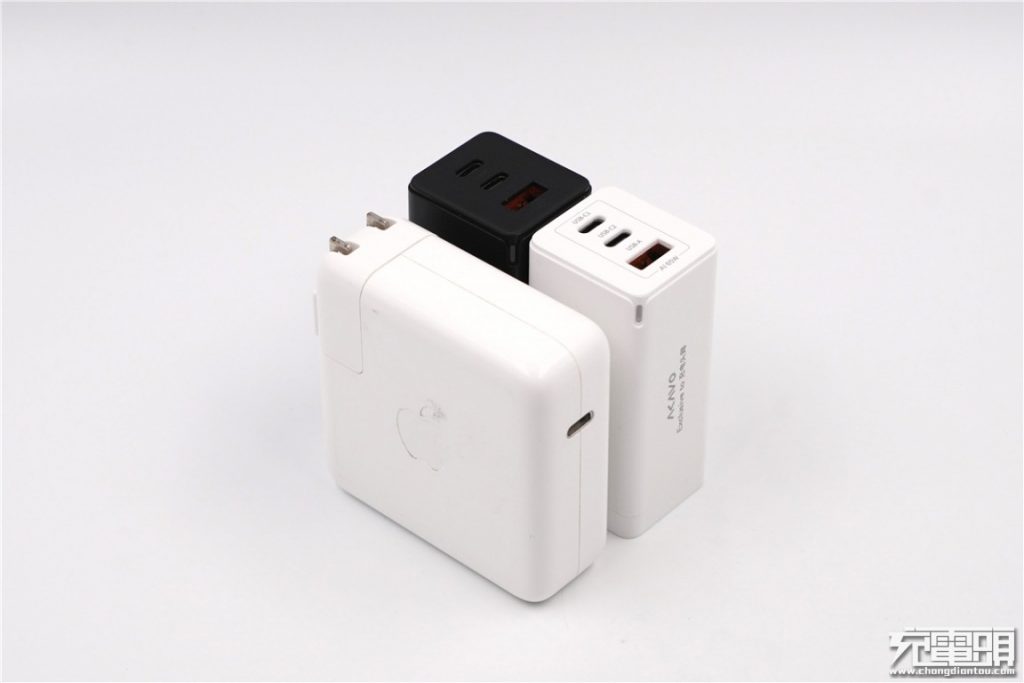
Compared to the Apple 61W PD charger.
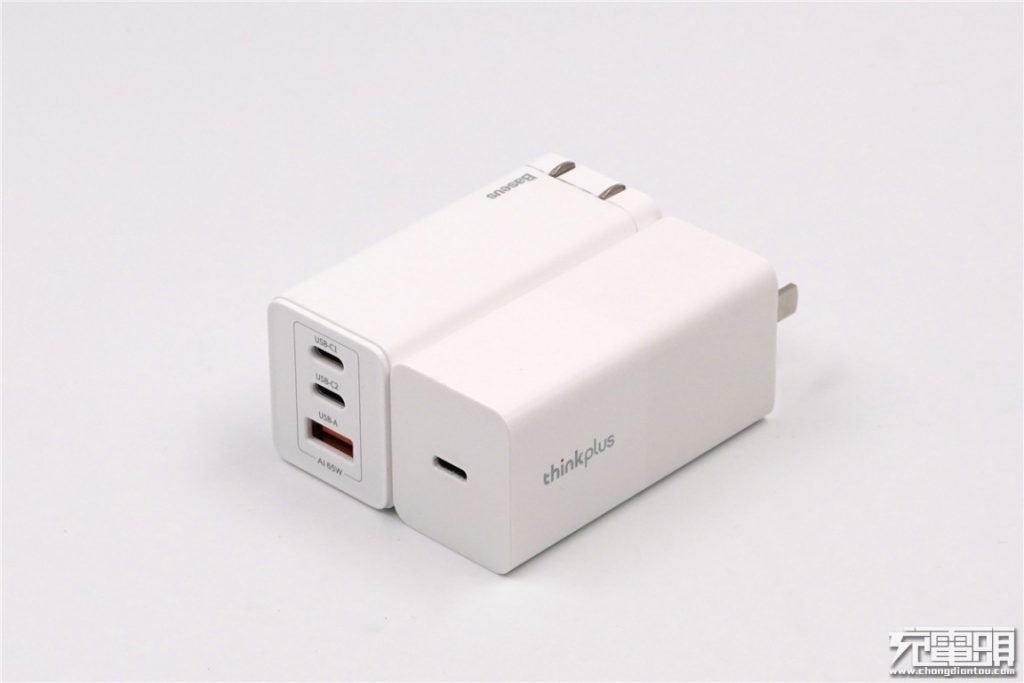
Compared to the Thinkplus 65W "lipstick" single port PD charger.
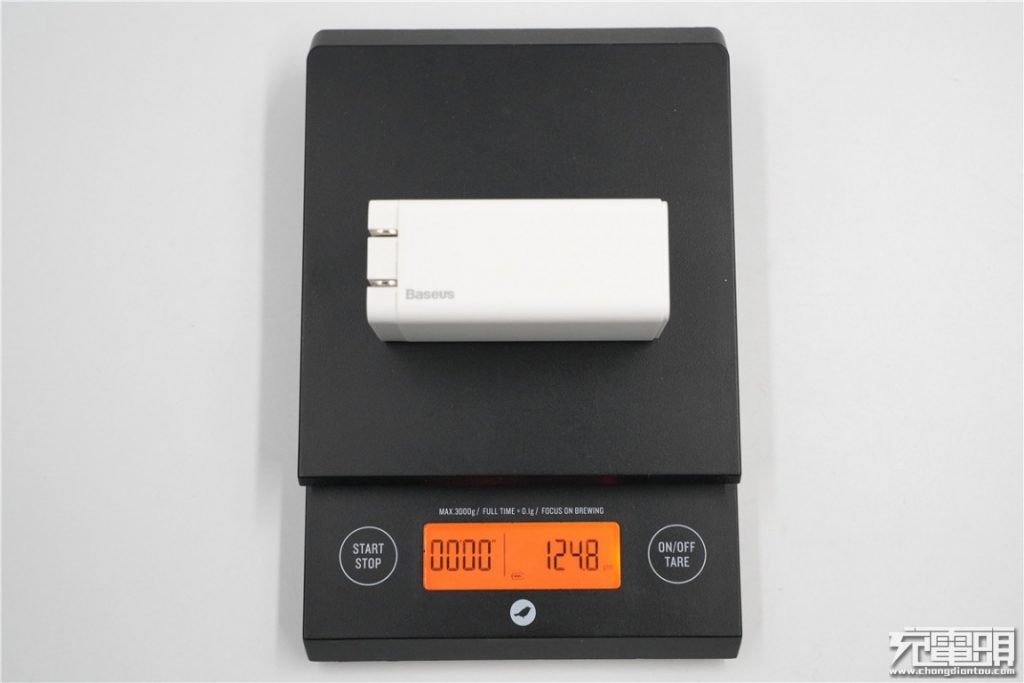
It weights 124.8g/4.4oz.
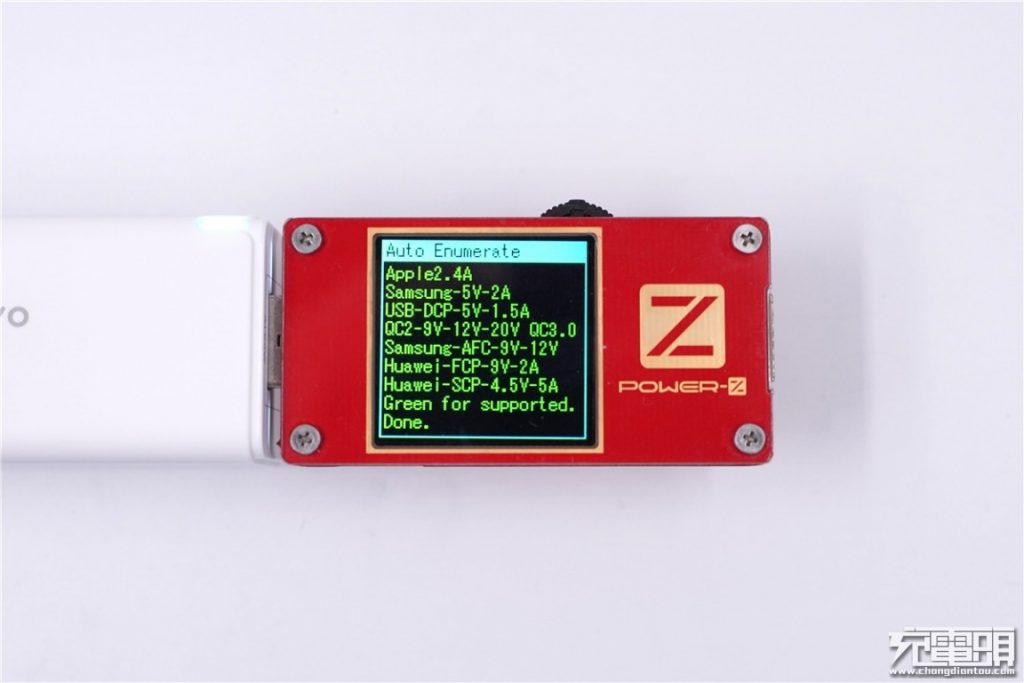
Using the ChargerLAB POWER-Z KT001, we can see its USB-A port covers a wide range of charging protocols including Apple 2.4A, DCP, QC 2.0, QC 3.0, AFC, FCP, and SCP.
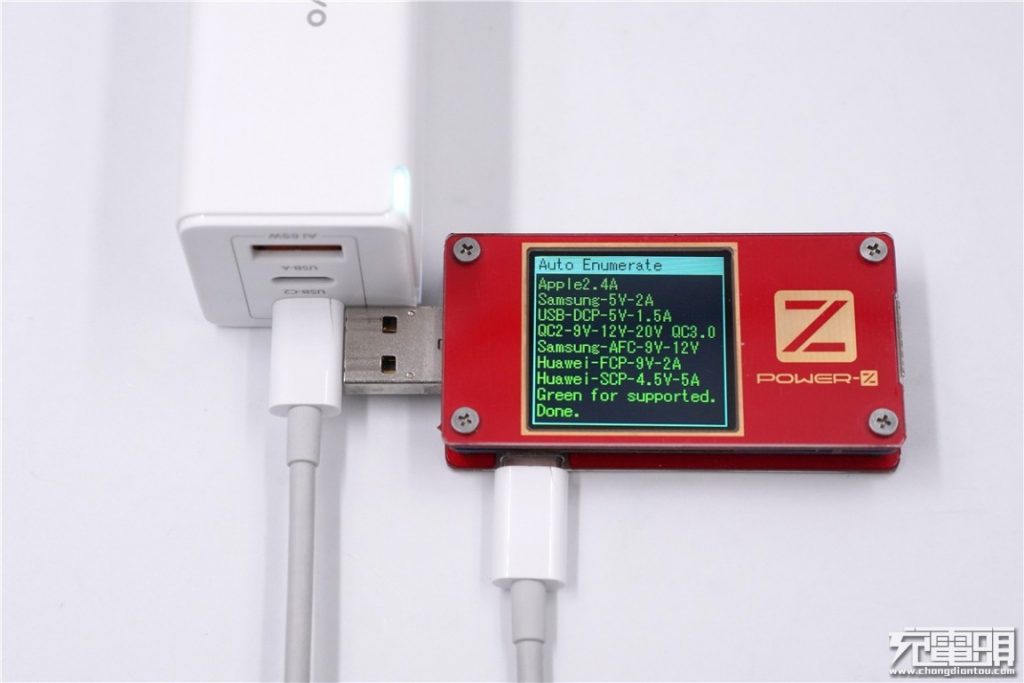
So does the USB-C1 port.
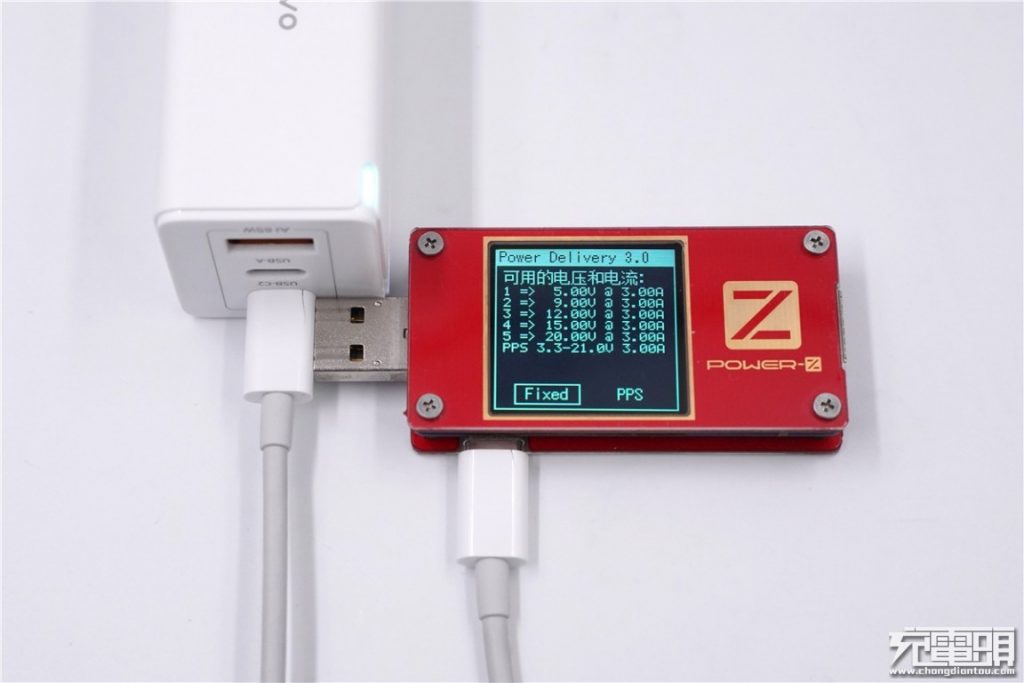
The USB-C1 port also supports USB PD 3.0 PPS with 5V/3A, 9V/3A, 12V/3A, 15V/3A, 20V/3A PDO steps and a 3.3V-21V/3A PPS step.
According to Akavo, in order to prevent some of the cable problems, the USB-C1 port turns off the 65W maximum output by default (which means 60W max for USB-C1 by default). The way to enable 65W output is to plug and unplug the USB-C2, then you can use a 5A E-Marked cable to pull the full 65W from the USB-C1 port.
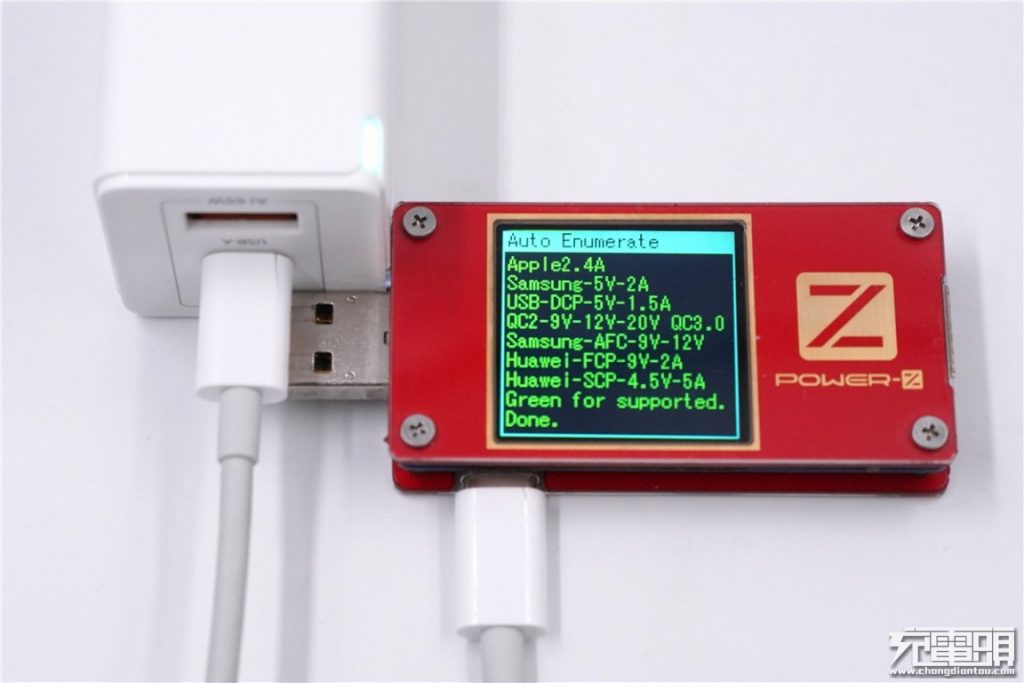
The USB-C2 port also supports Apple 2.4A, DCP, QC 2.0, QC 3.0, AFC, FCP, and SCP.
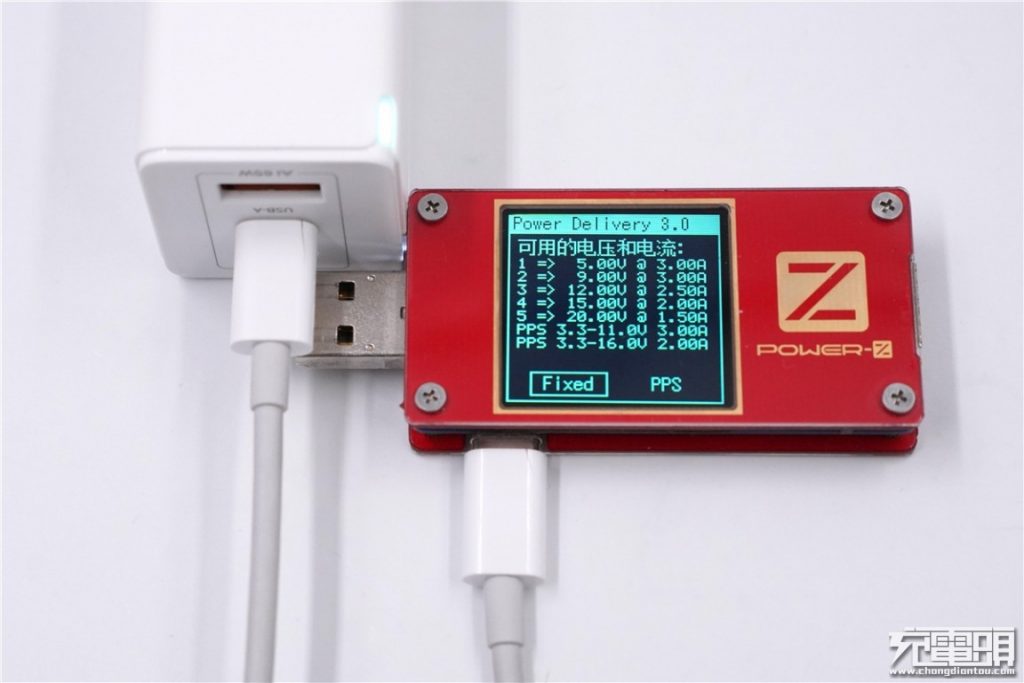
The USB-C2 port also supports USB PD 3.0 PPS with 5V/3A, 9V/3A, 12V/2.5A, 15V/2A, 20V/1.5A PDO steps and 3.3V-11V/3A, 3.3V-16V/2A PPS steps.
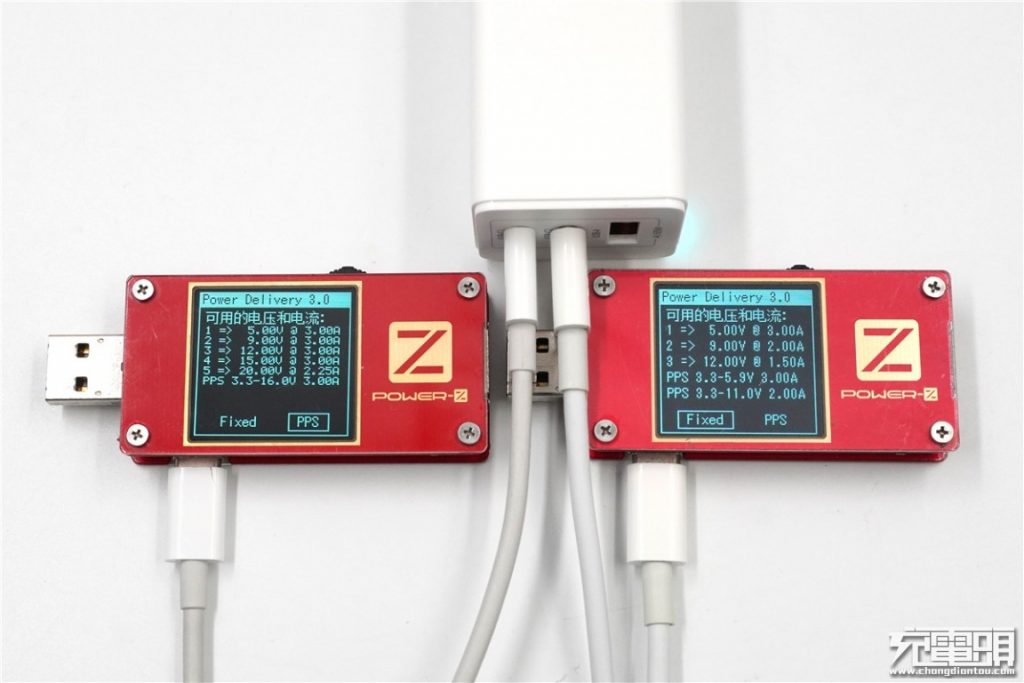
When both of the two USB-C ports are used:
USB-C1 output will change to: 5V/3A, 9V/3A, 12V/3A, 15V/3A, 20V/2.25A and 3.3V-16V/3A (PPS)
USB-C2 output will change to: 5V/3A, 9V/2A, 12V/1.5A, and 3.3V-5.9V/3A (PPS), 3.3V-11V/2A (PPS)
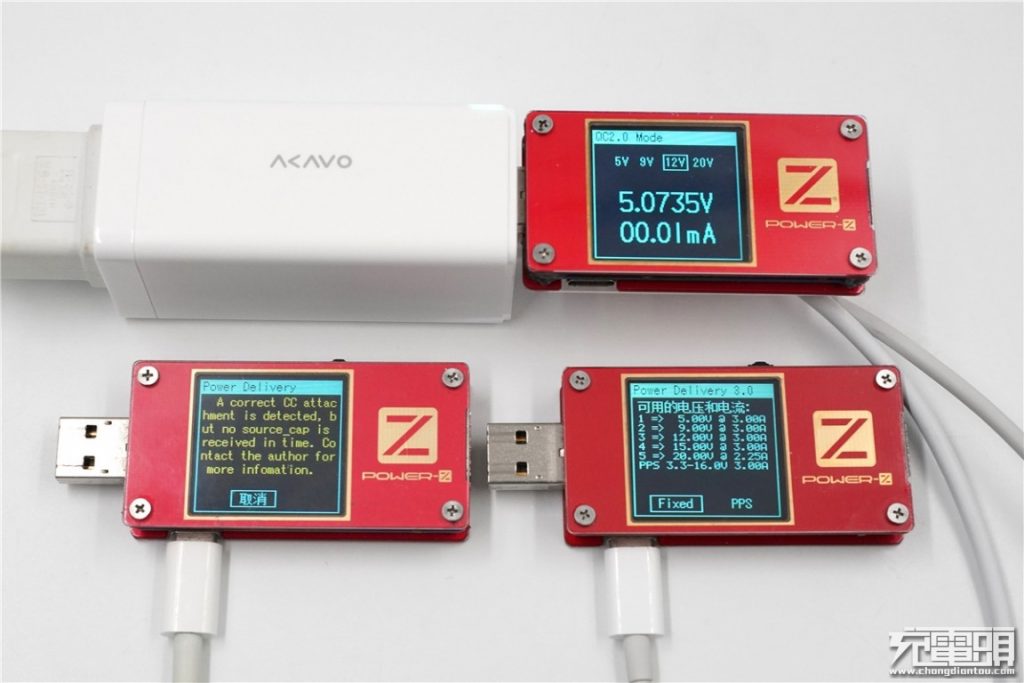
When all the ports are used, the USB-C2 and USB-A will be locked to 5V, while the USB-C1 can still output 45W max PDO, or 48W PPS.
II Teardown
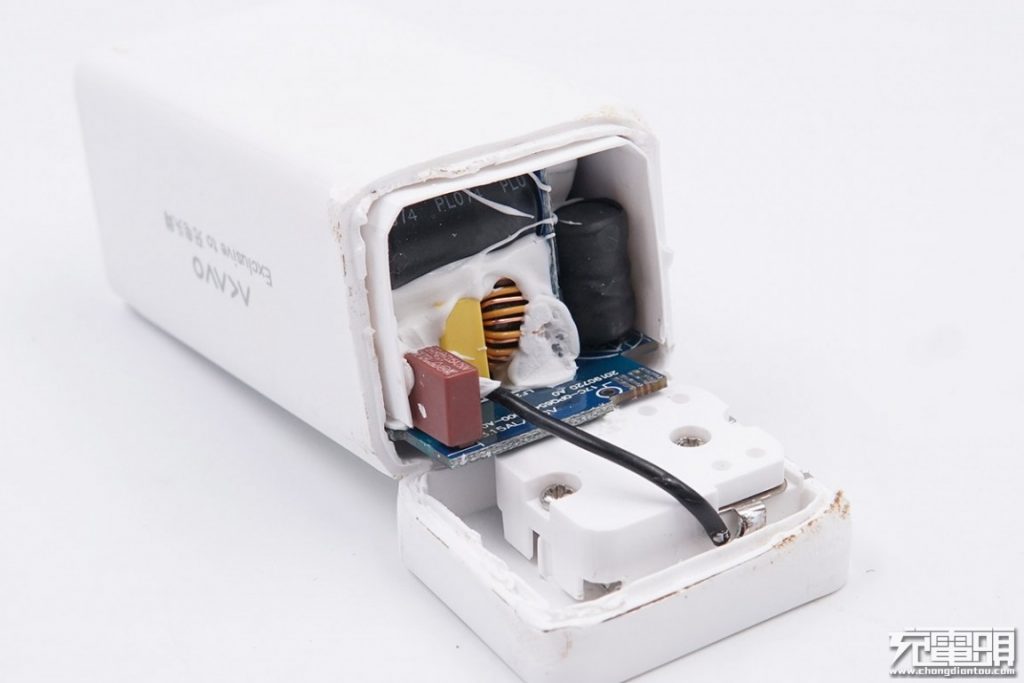
The casing uses ultrasonic welding. Open from the AC prongs side, and AC pin is wired to the PCB.
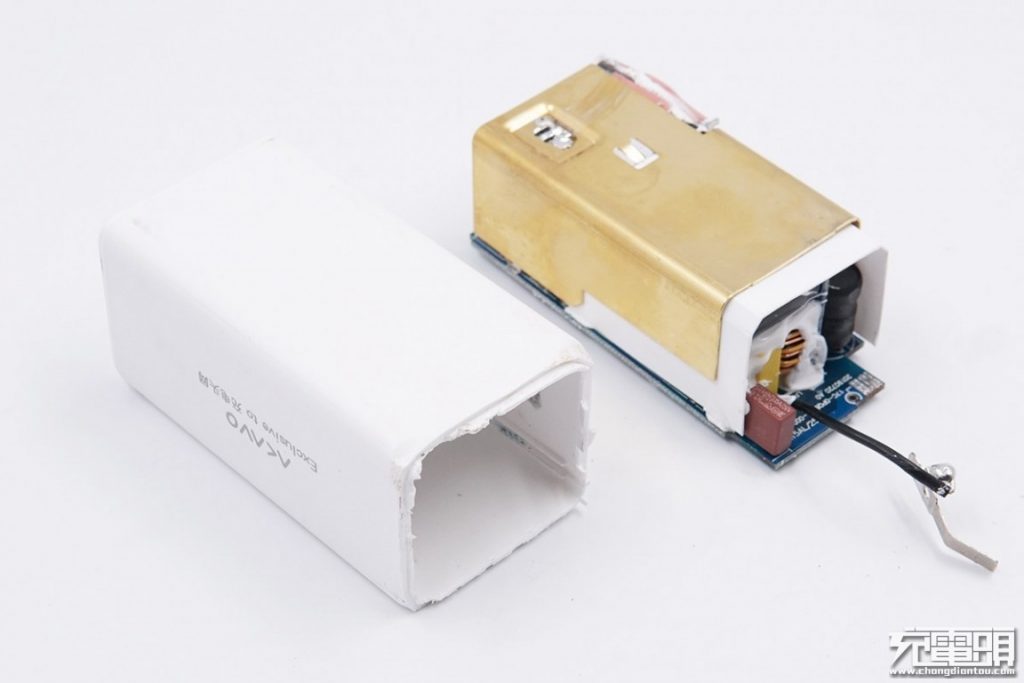
Pull out the PCBA module which is covered by a large metal heat sink.
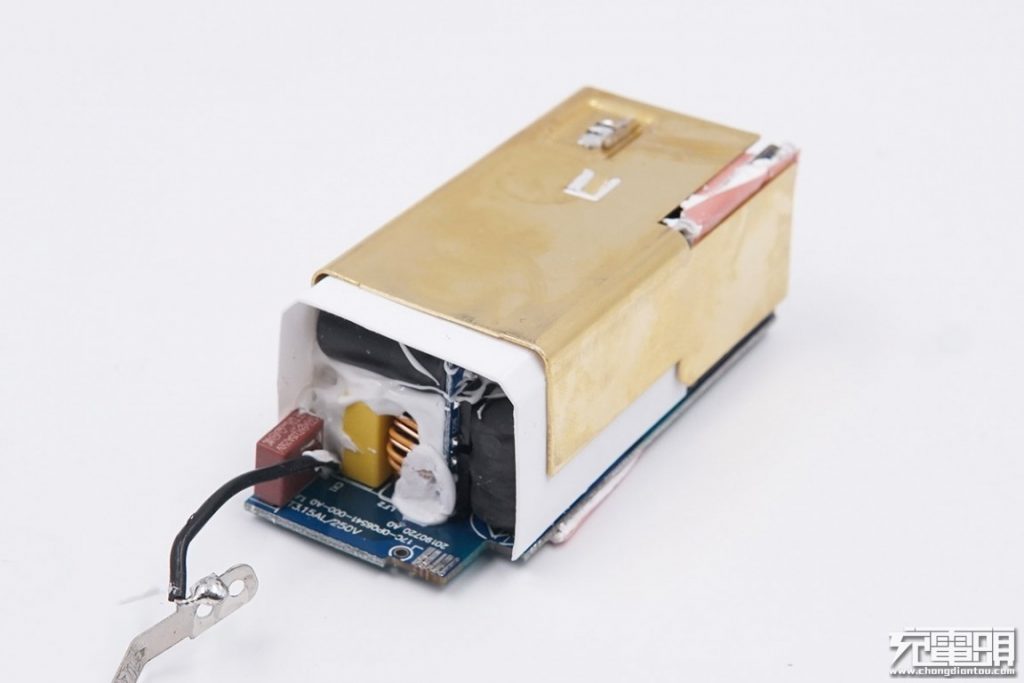
As can be seen from the input side, the internal components are filled with thermal silica gel.
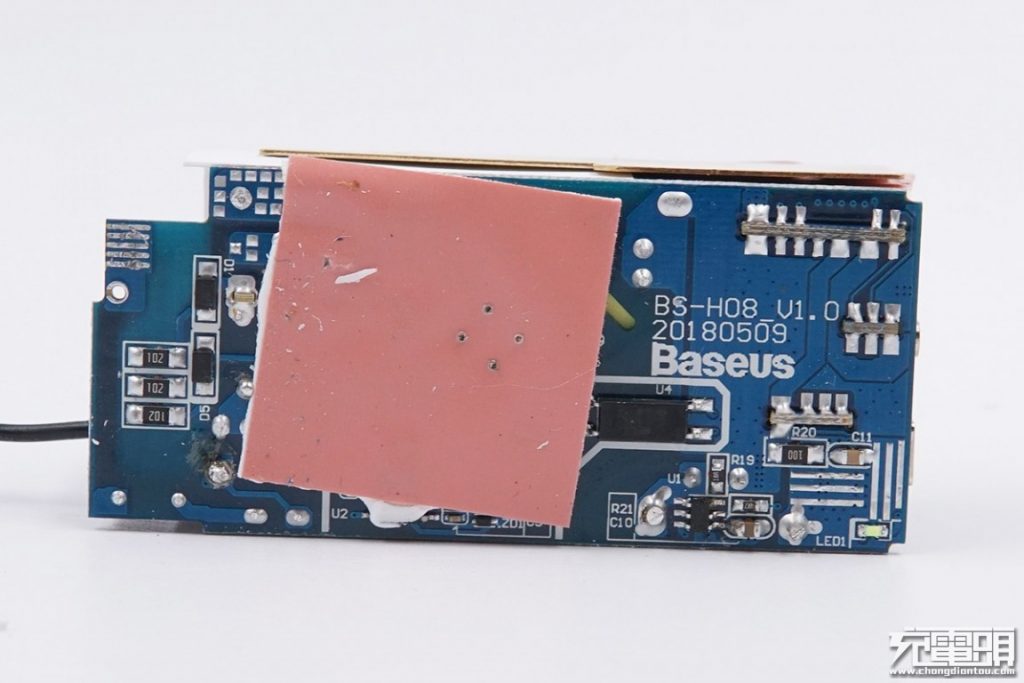
A large thermal pad on the back of the PCB, and we can see a Baseus logo.
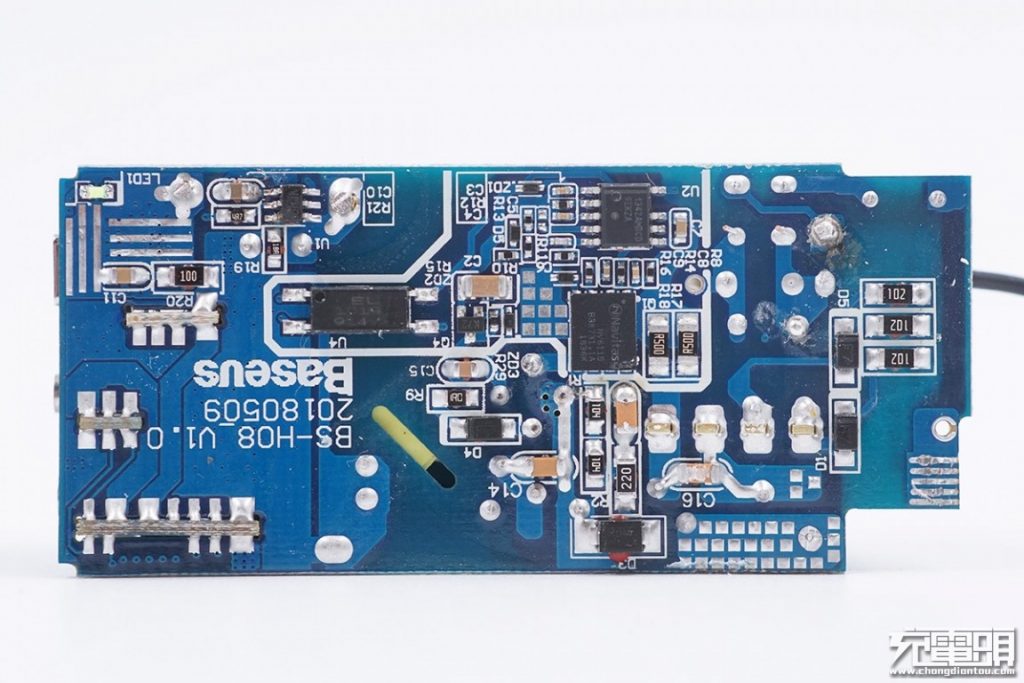
Removing the thermal pad reveals a main controller chip and a GaN (gallium nitride) chip on the primary side of the PCB. There is a synchronous rectification control chip on the secondary side. Sufficient safety distance is reserved between the primary side and secondary side with a hollowed-out design. An optocoupler feedback chip is placed between the two sides.
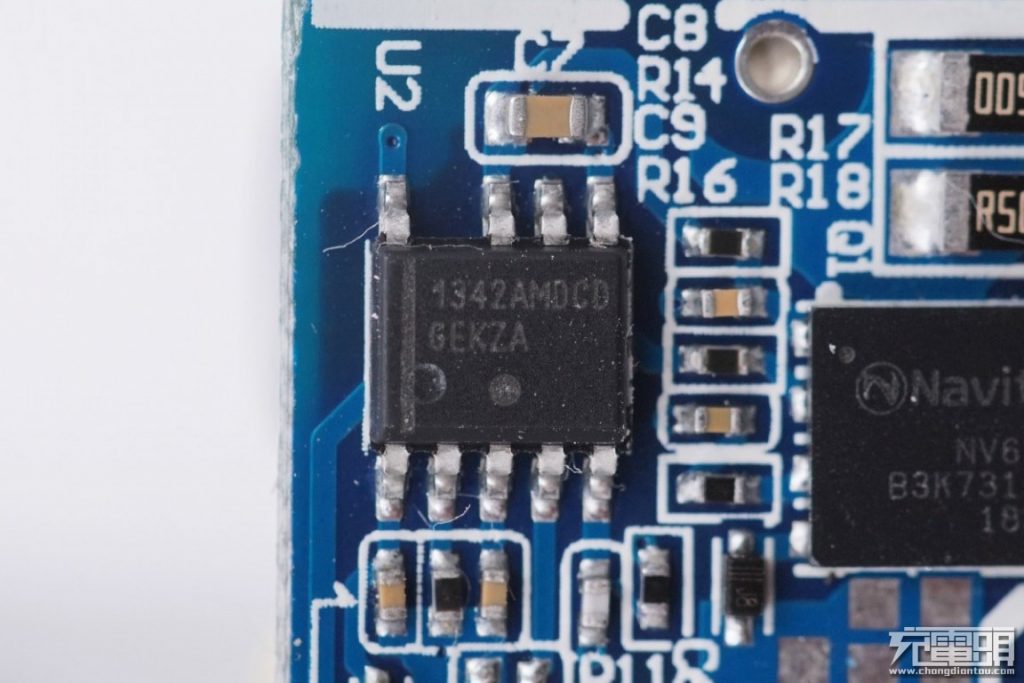
The charger's main controller chip comes from ON Semiconductor, model NCP1342.
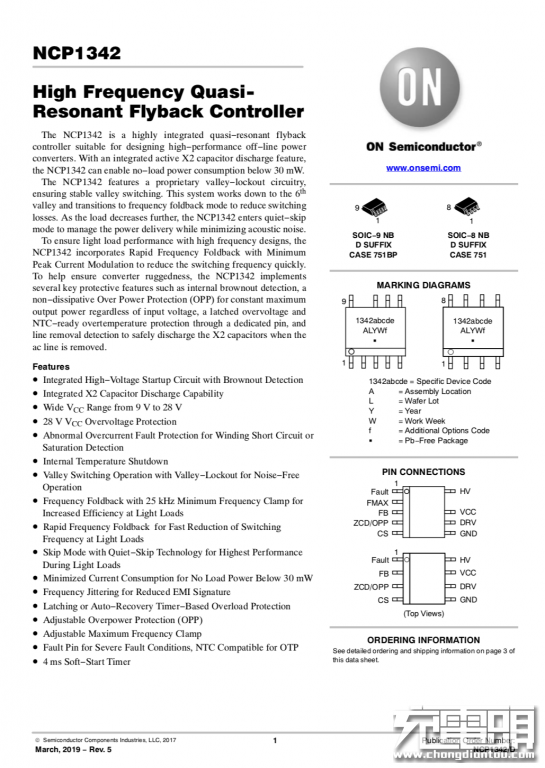
Detailed specifications of the ON Semiconductor NCP1342.
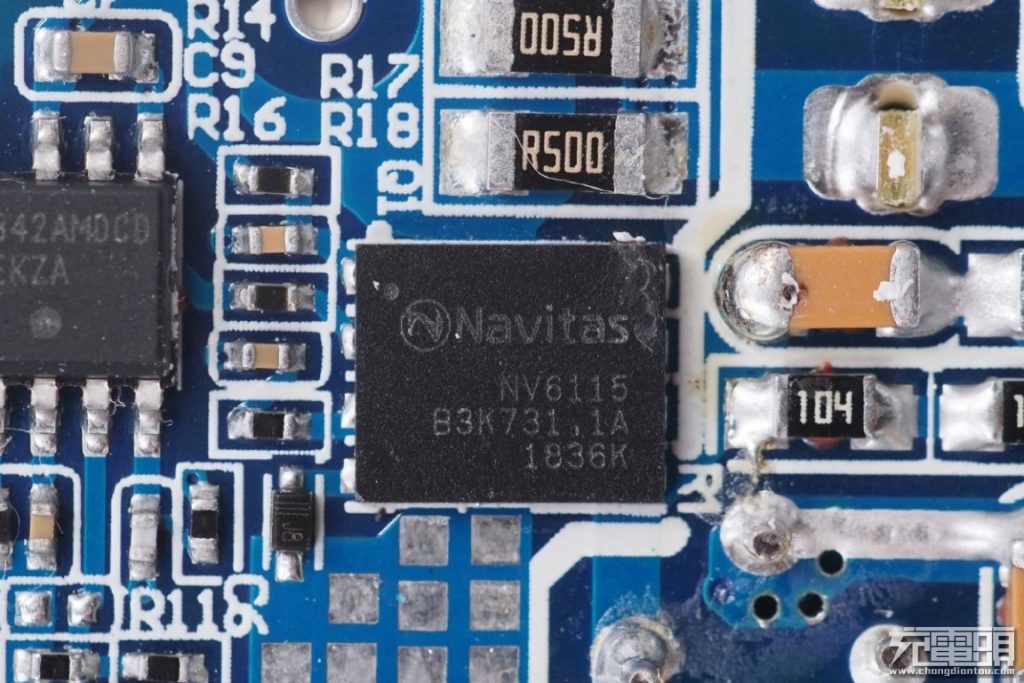
NV6115 GaN power IC from Navitas Semiconductor with built-in driver, 170mΩ resistance, and 650V withstand voltage. It supports 2MHz switching frequency and comes in 5*6mm QFN package to save space. We have seen the use of this chip inside the RAVPower 45W Ultrathin and AUKEY 27W PA-Y19.
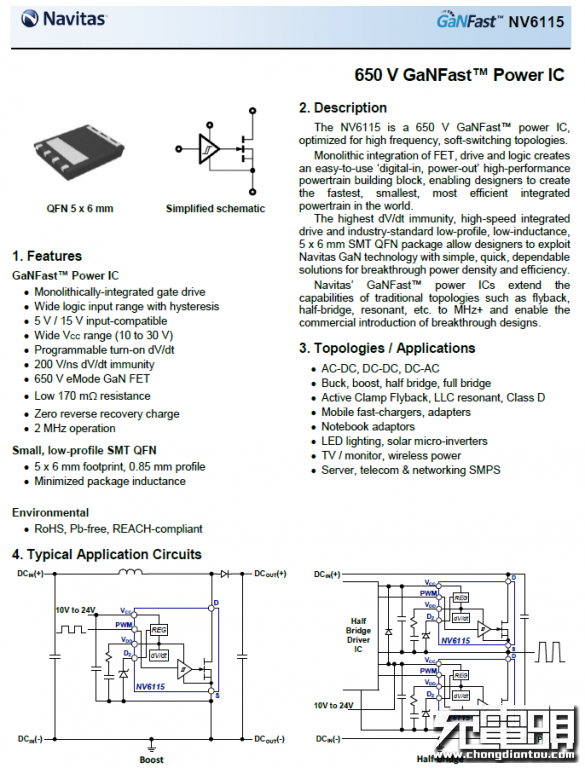
Detailed specifications of the Navitas NV6115.
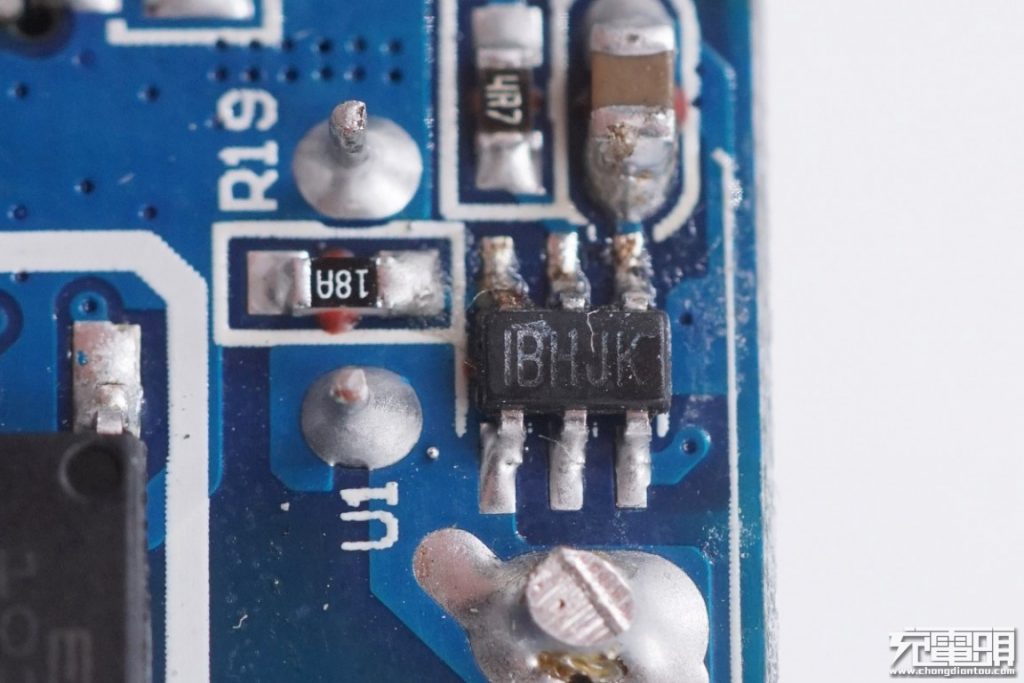
The secondary synchronous rectification chip with letter code IBHJK comes from MPS, model MP6908.

Detailed specifications of the MPS MP6908.
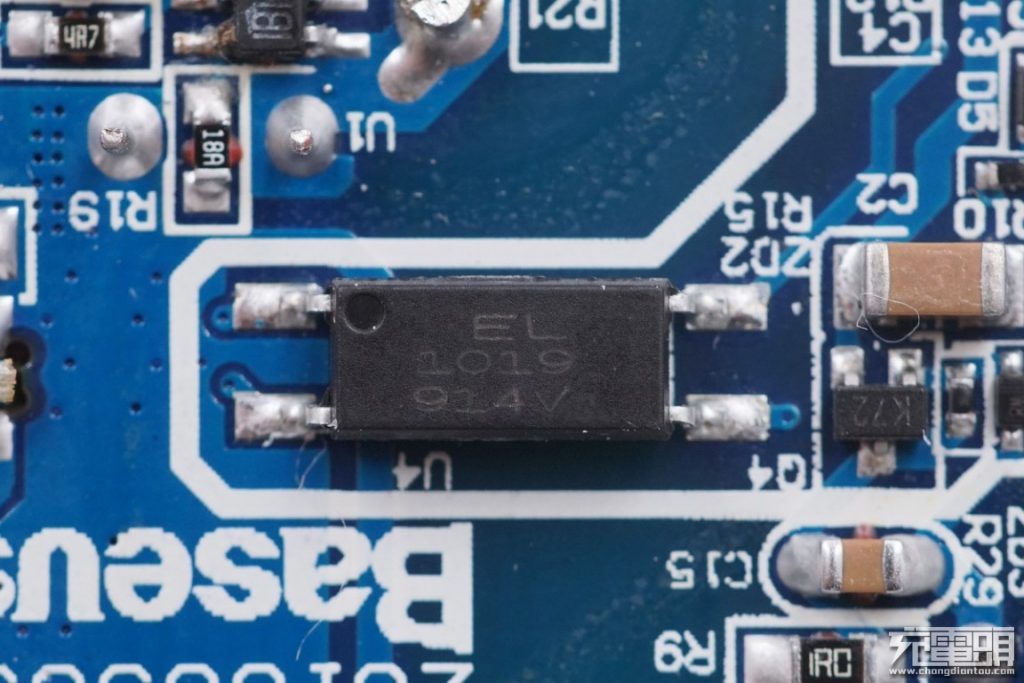
An EL optical optocoupler used for output voltage feedback.
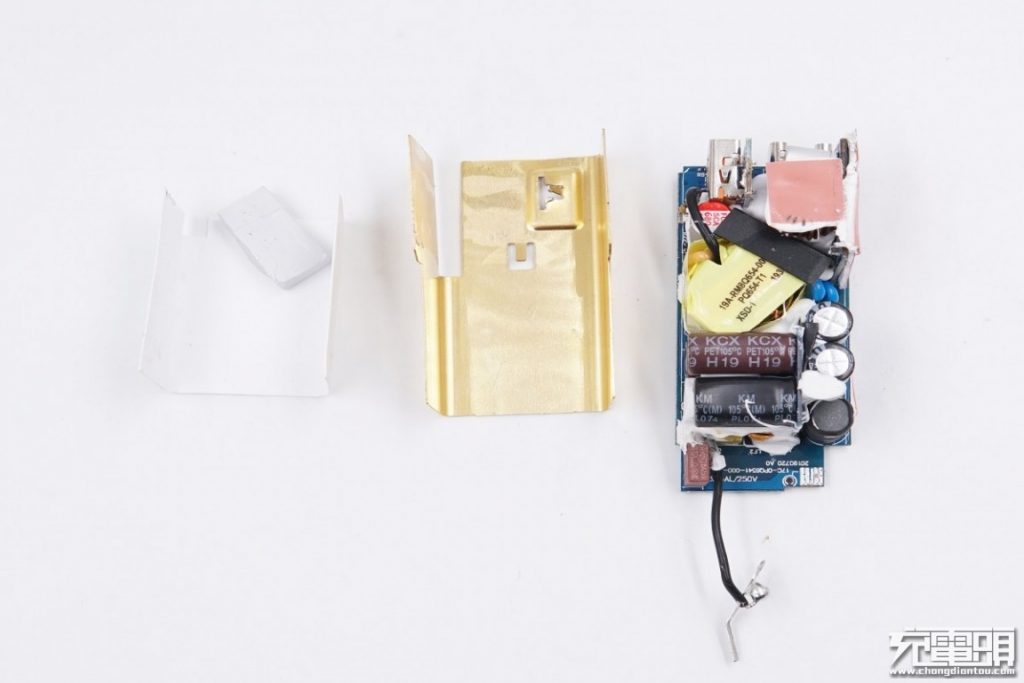
Remove the metal heat sink. The plug-in components are densely populated and fixed with silicone. There are multiple filter electrolytic capacitors at the input end.
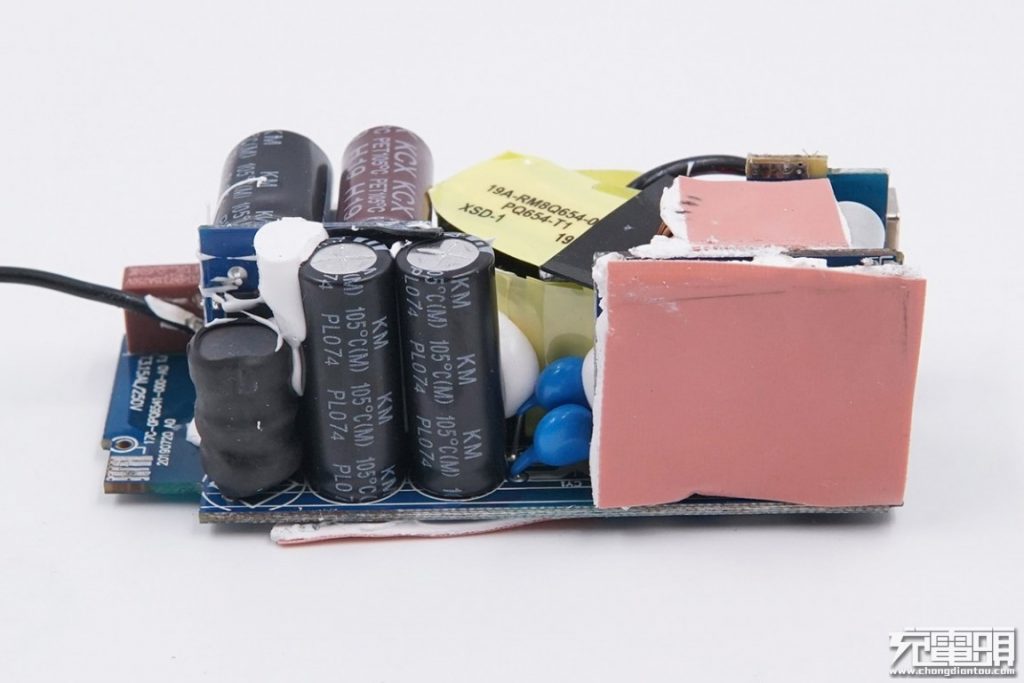
Side view, another thermal pad.
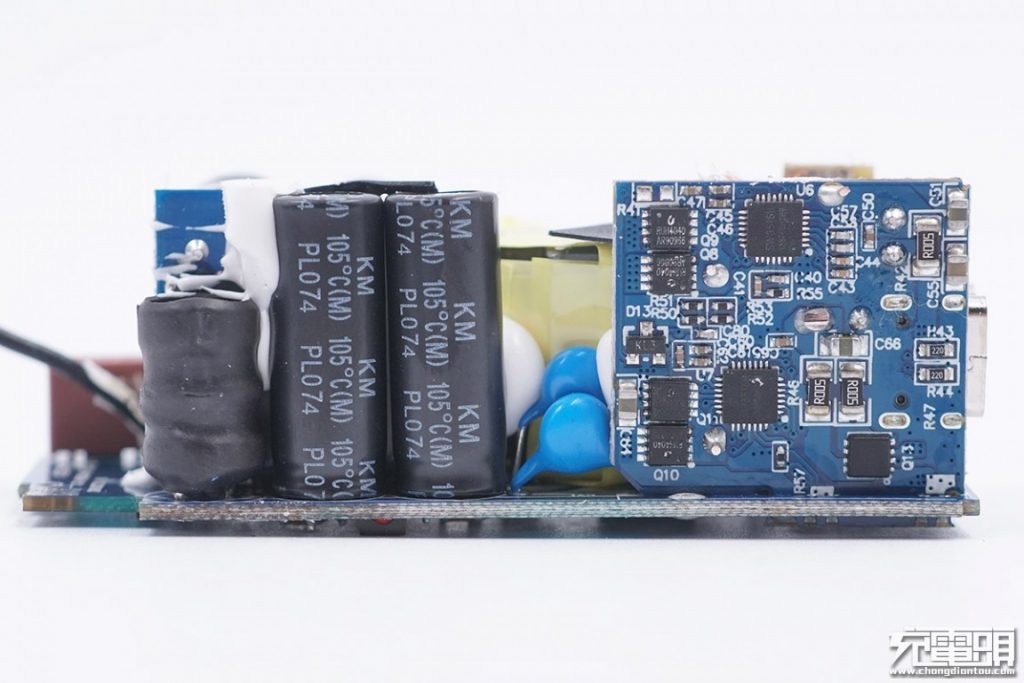
There are two anti-interference Y capacitors between the primary and secondary. The secondary uses a secondary step-down circuit, and the daughter board of the secondary is vertically mounted onto the main PCB.
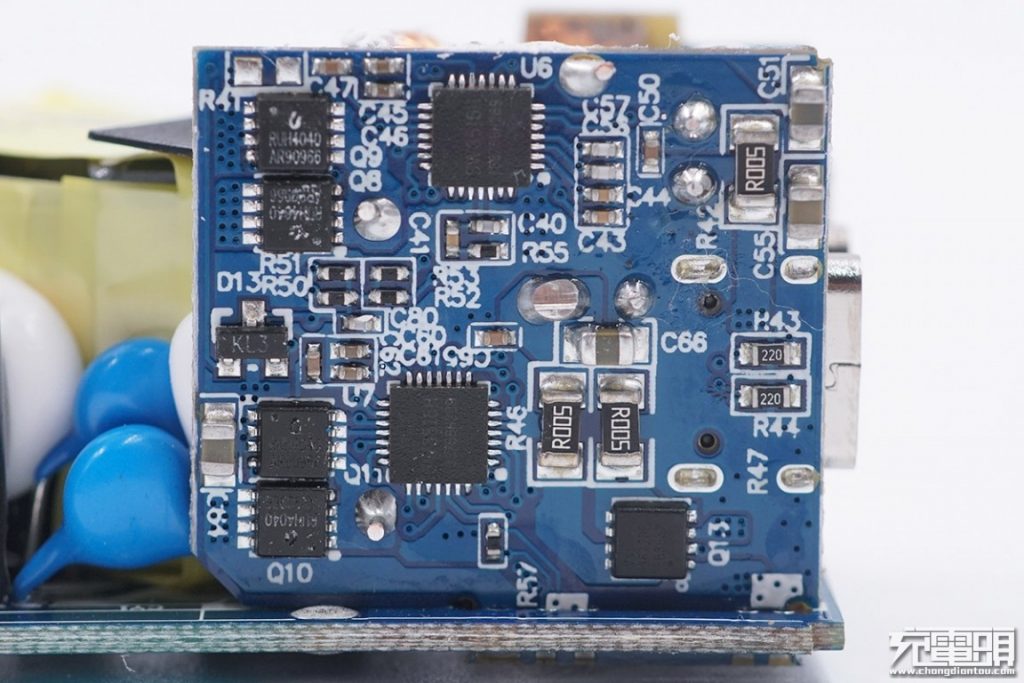
Overview of the secondary step-down circuit. Each of the two chips works with two MOSFETs to complete the independent step-down output, and one MOS in the lower right corner is the output VBUS switch of the USB-C port.
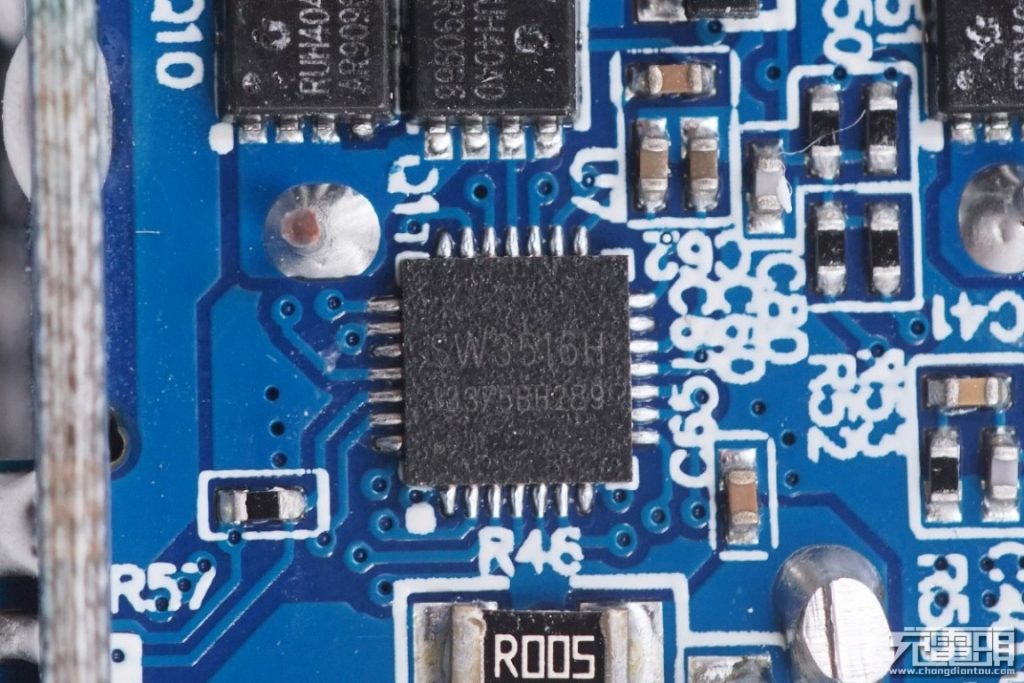
An iSmartWare SW3516H is used for step-down control and protocol identification of the USB-C port. The SW3516H is a highly integrated power management IC for dual ports fast charge application, and supports dual ports of Type-C and Type-A. It integrates 5A synchronous buck, PPS/PD/QC/AFC/FCP/SCP/PE/SFCP fast charge protocol, PD 100W(20V@5A) maximum output power, CC/CV mode and dual ports controller. With simple external components, the SW3516H provides a turn-key high efficiency solution for dual ports fast charge application.
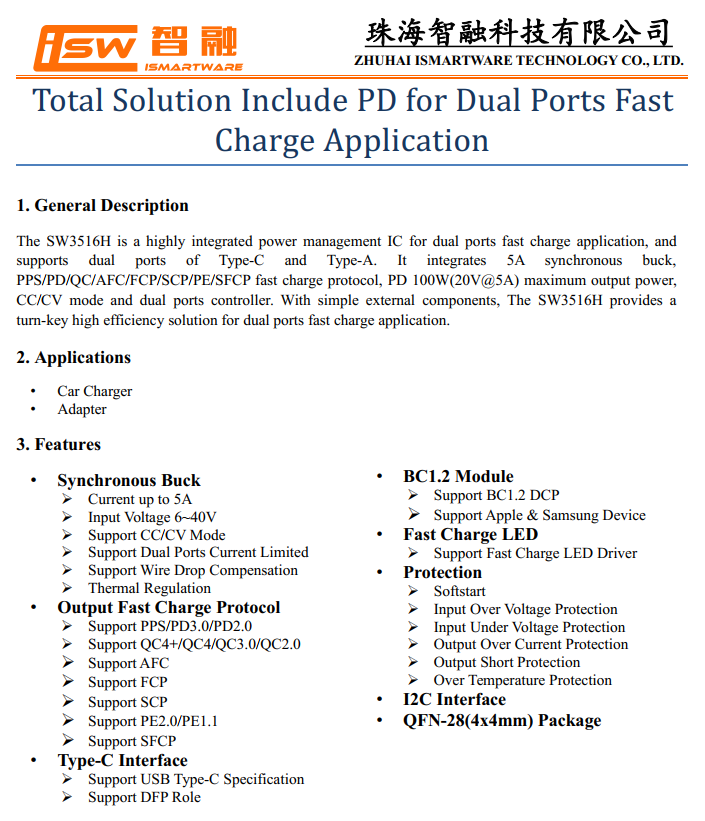
Detailed specifications of the iSmartWare SW3516H.
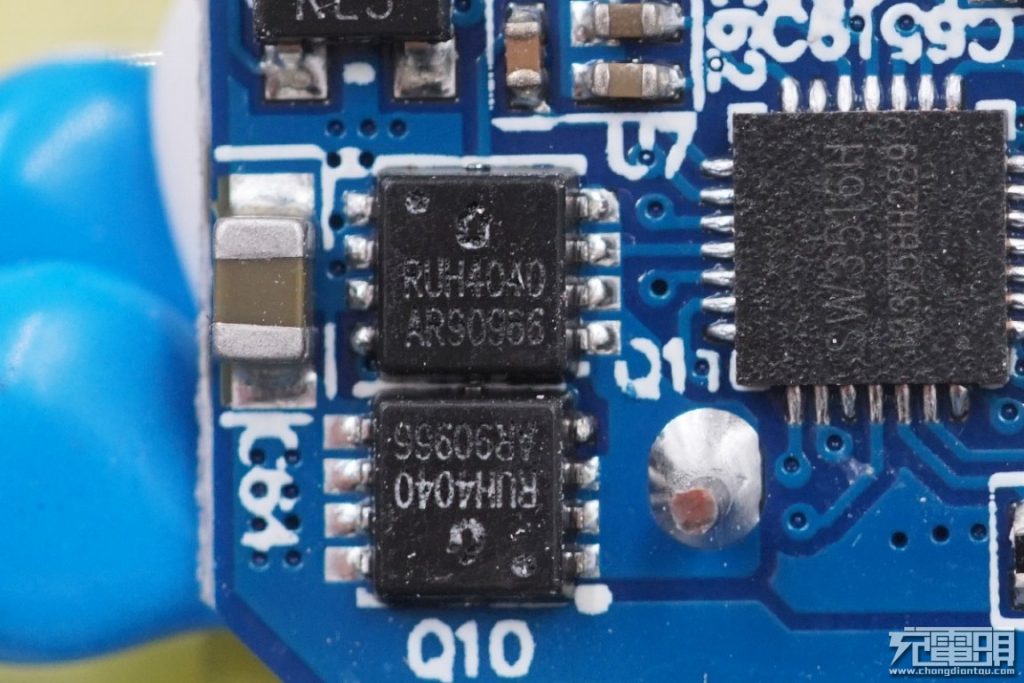
Two MOSFETs from Ruichips, model RUH4040M2.
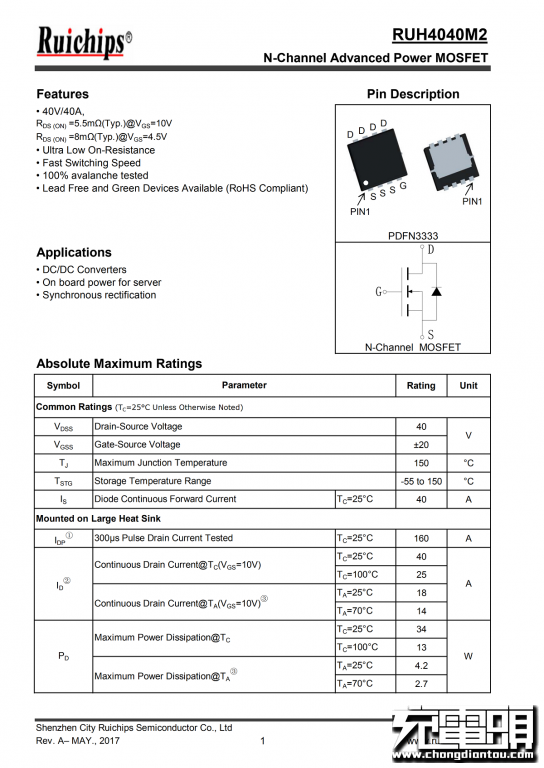
Detailed specifications of the Ruichips RUH4040M2.
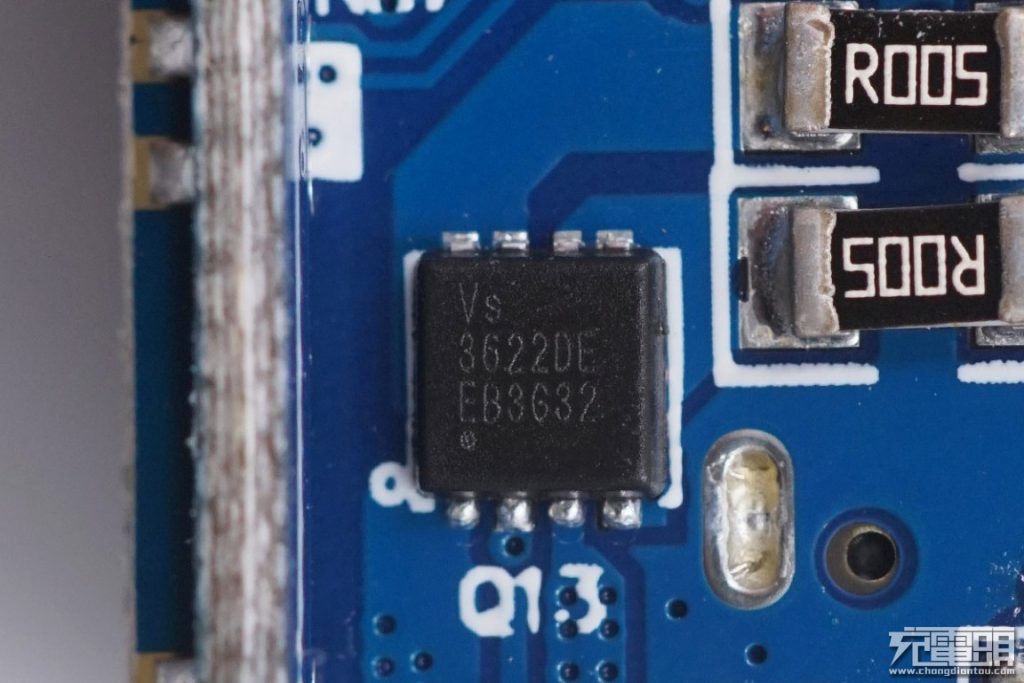
USB-C port output VBUS switch from Vanguard Semiconductor, model VS3622DE. It is a dual N-channel MOS with 5V logic level control, here used for independent protection of two output ports.
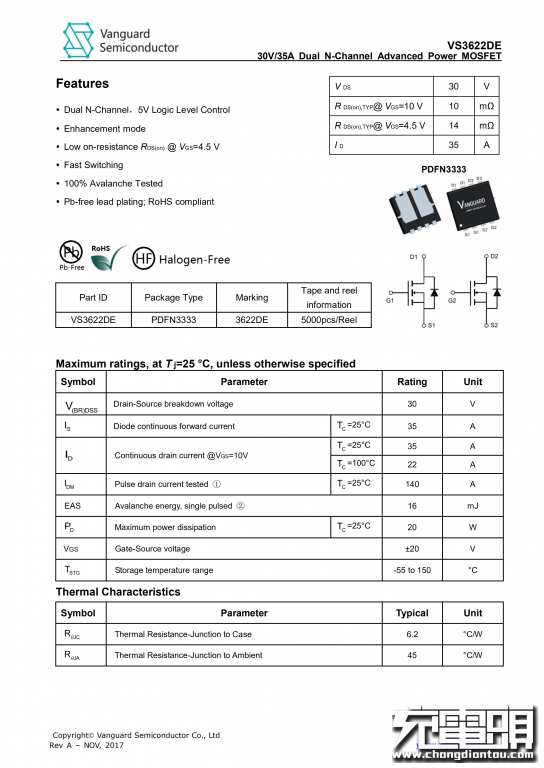
Detailed specifications of the Vanguard VS3622DE.
Another iSmartWare SW3516H with two Ruichips RUH4040M2 for the output of the USB-A port and USB-C port.
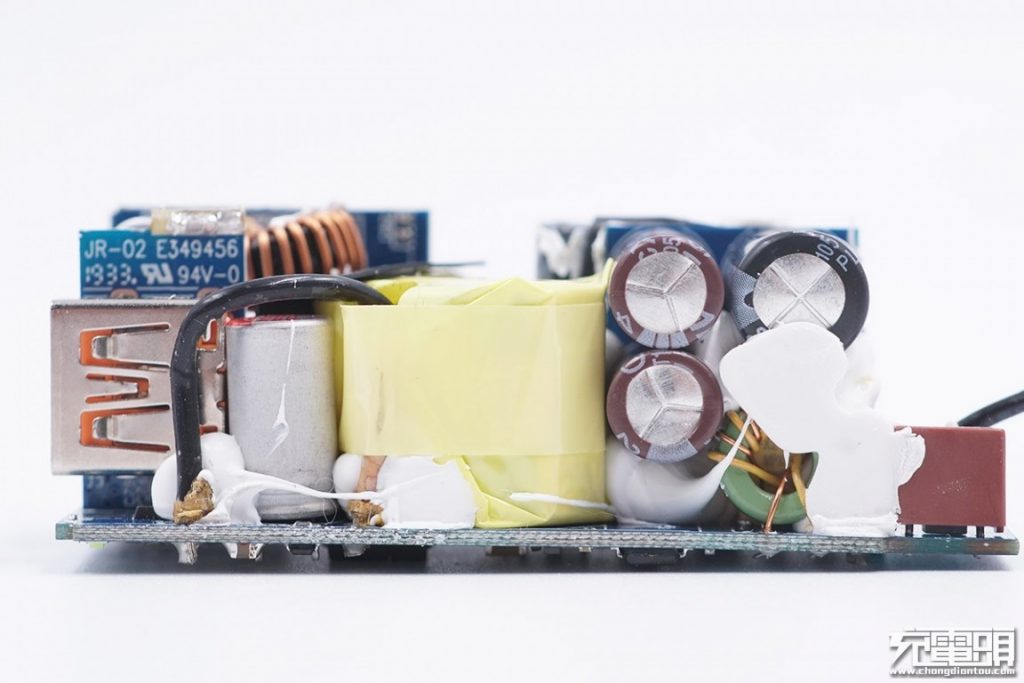
Looking from another angle, there are three horizontally placed aluminum electrolytic capacitors tightly stacked to save space. As we know, the transformer is a heat-generating component, so the working environment of the two electrolytic capacitors close to the transformer is quite demanding. The capacitors are rated 105°C, though.
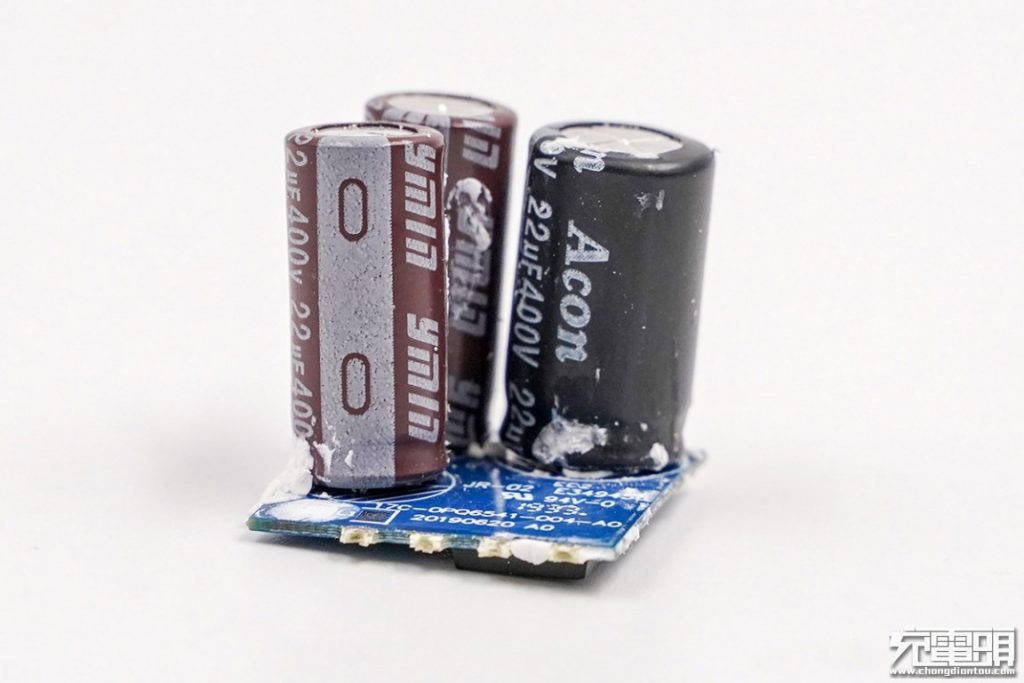
The capacitors are from Ymin and Acon, with a same 400V 22μF spec.
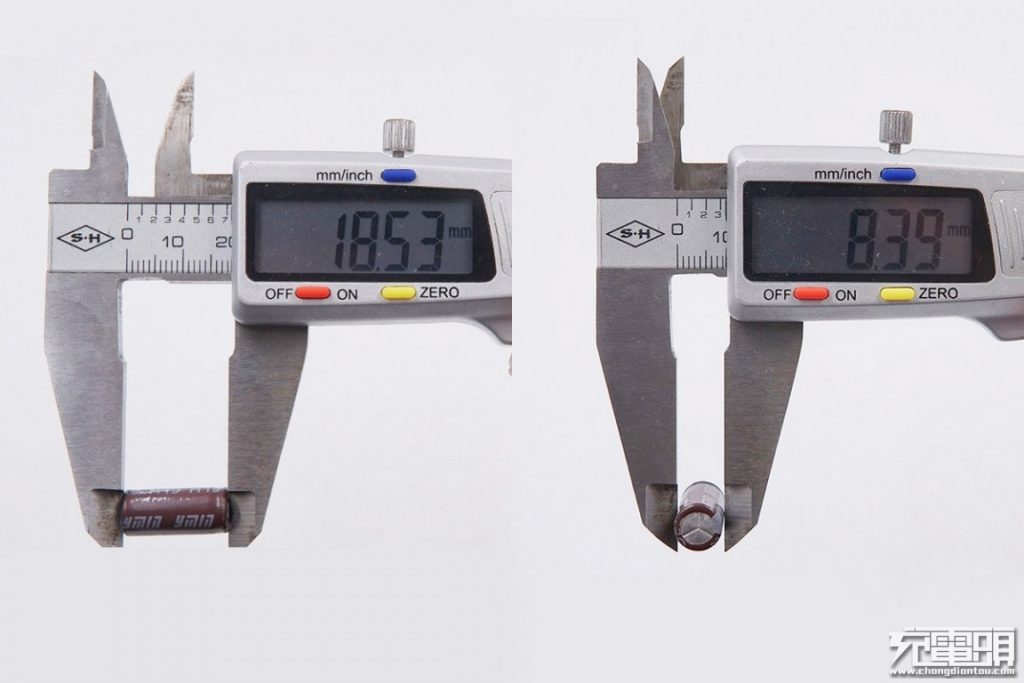
Two of Ymin's aluminum electrolytic capacitors are approximately 18.53mm long, 8.39mm in diameter and 1026mm3 in volume.
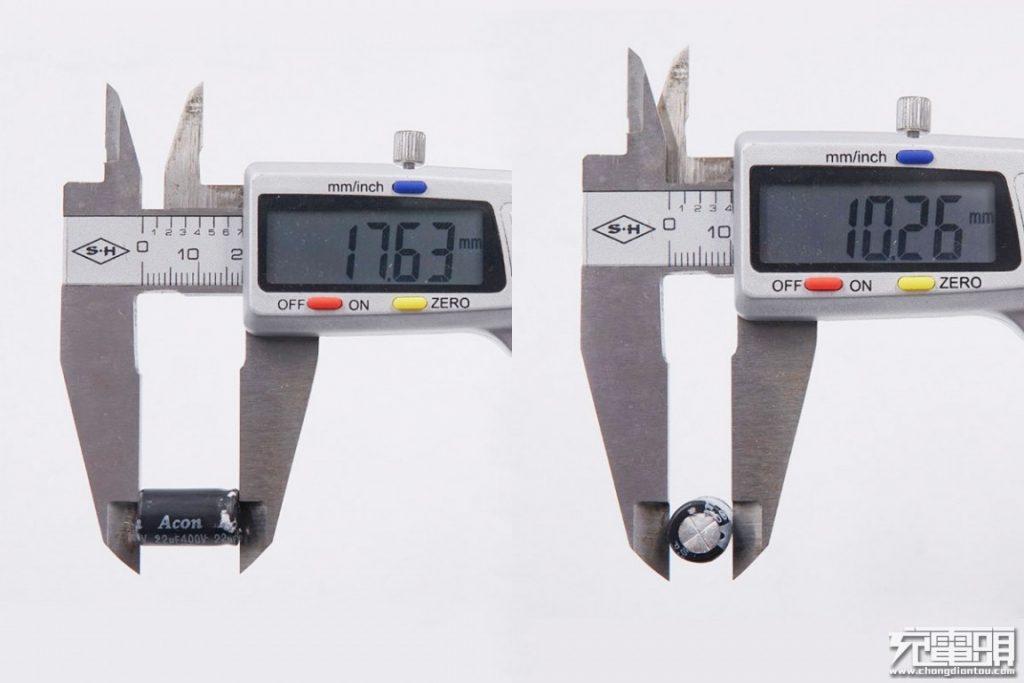
The Acon's electrolytic capacitor measures approximately 17.63 mm long, 10.26 mm in diameter, and has a volume of approximately 1456 mm3.
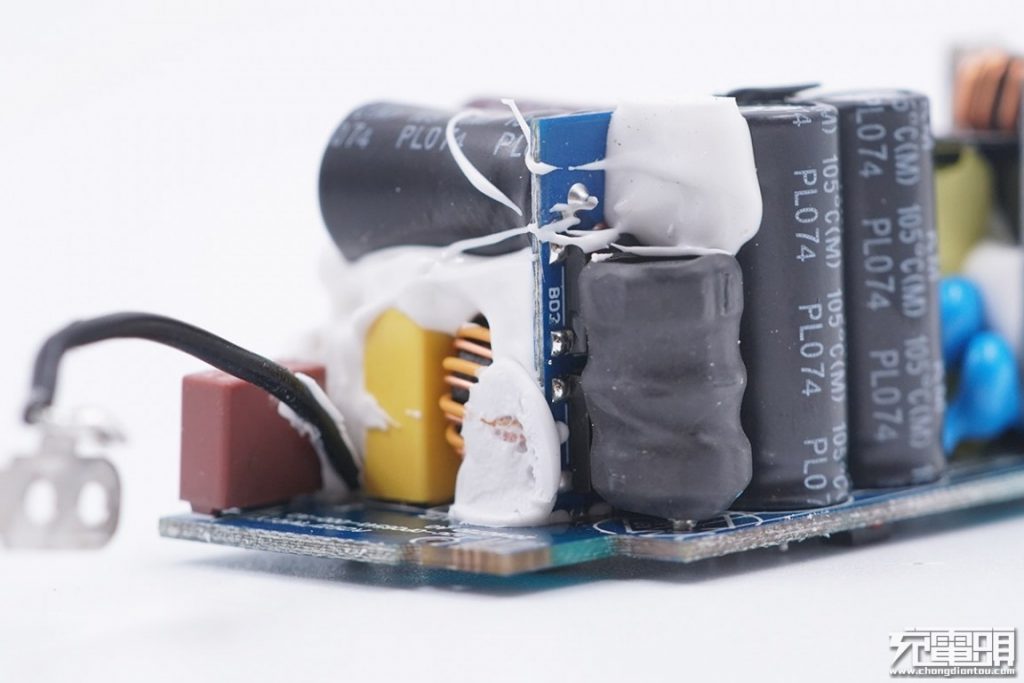
Other aluminum electrolytic capacitors.
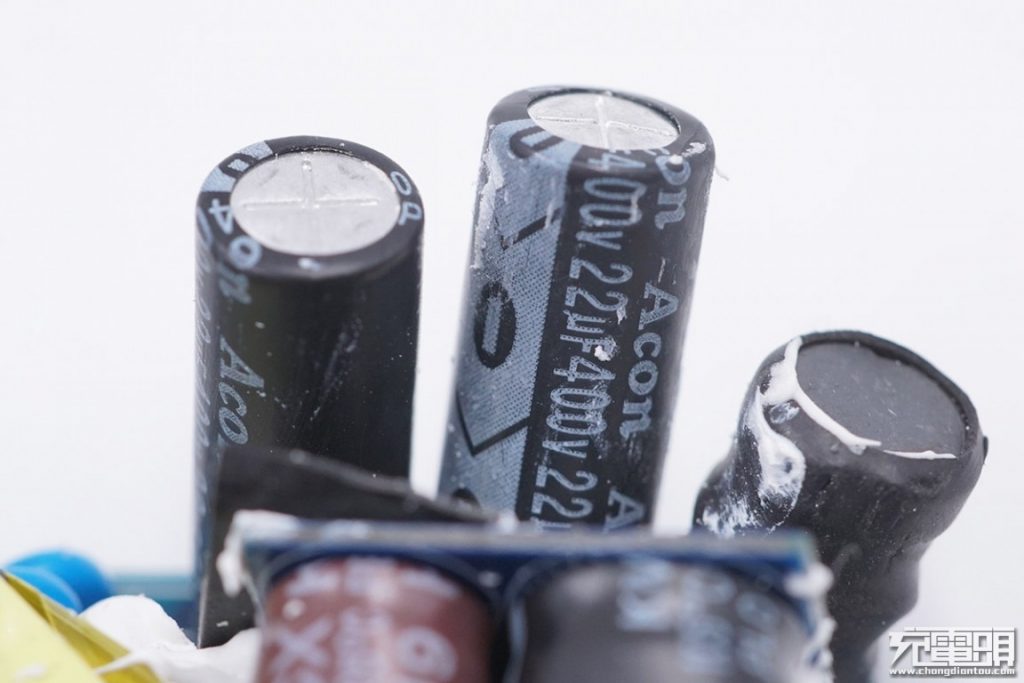
Two electrolytic capacitors are from Acon, 400V 22μF. So the total capacity of five aluminum electrolytic capacitors at the input side is 110μF.
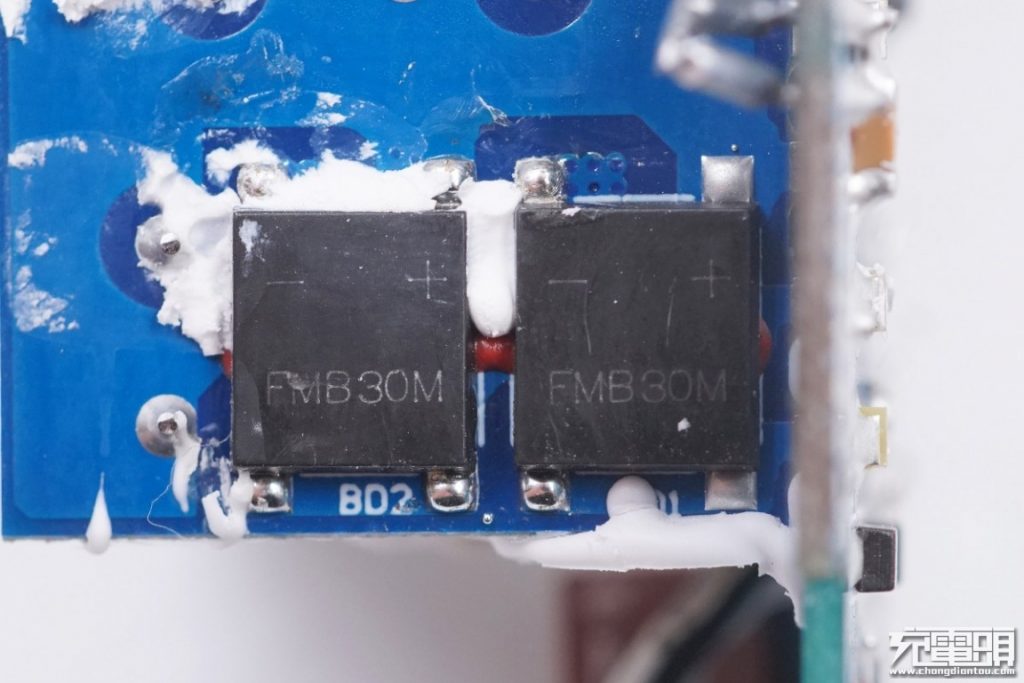
On the back of the daughter board are two input rectifier bridges, two in parallel to reduce heat.
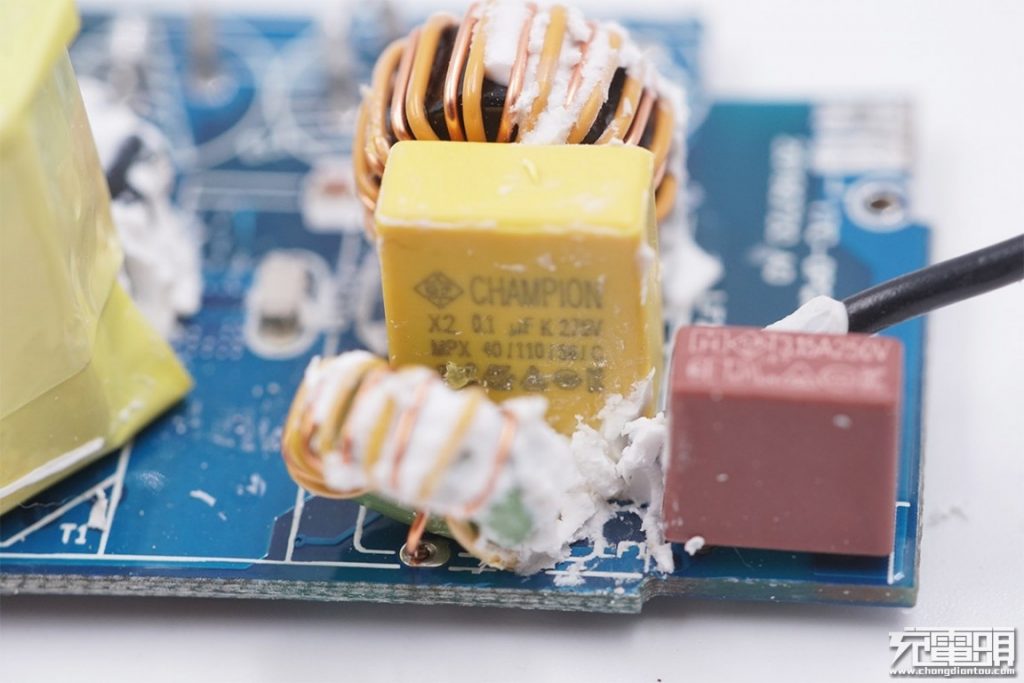
Two common-mode chokes are used at the input side to reduce EMI electromagnetic interference. The brand safety X capacitor is made by Dongguan Champion Electronic Technology Co., Ltd.
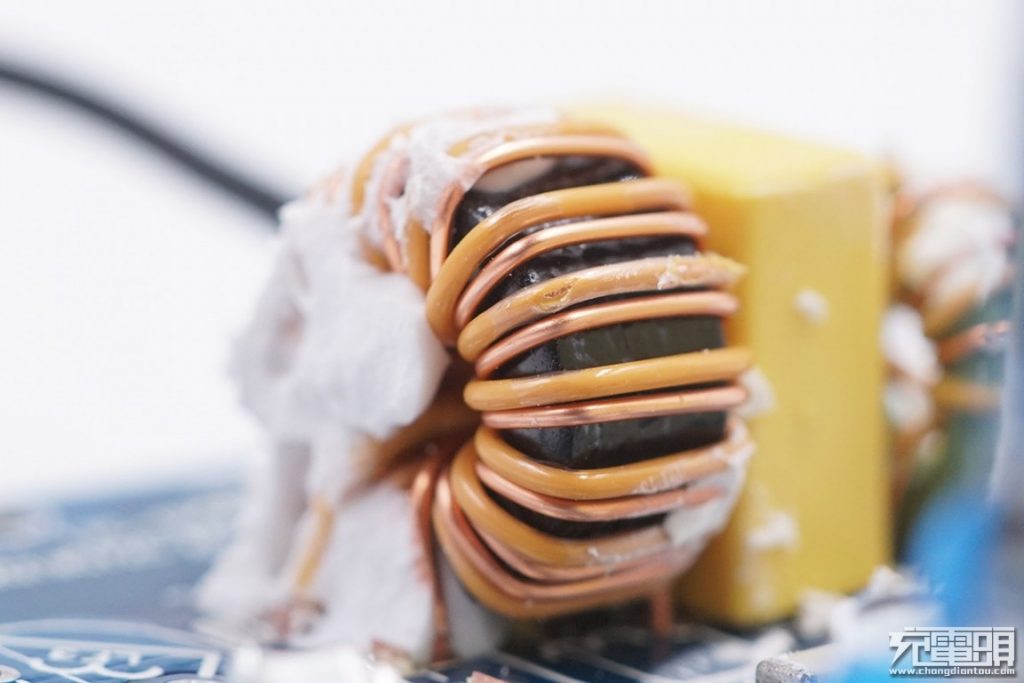
Close-up of the common-mode choke.
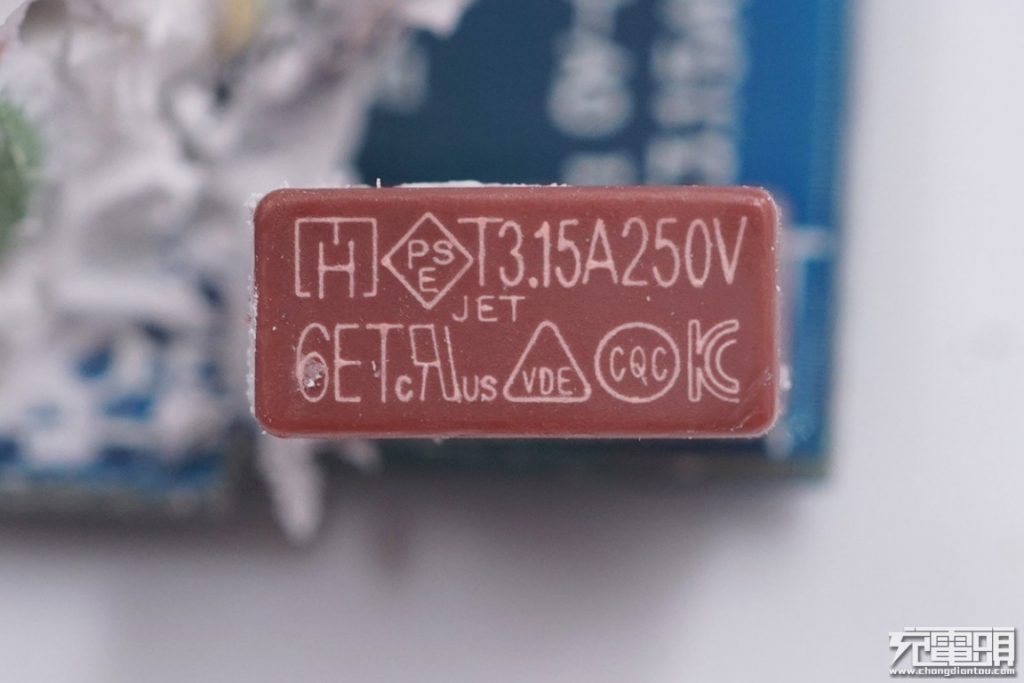
Input delay fuse, 3.15A 250V.
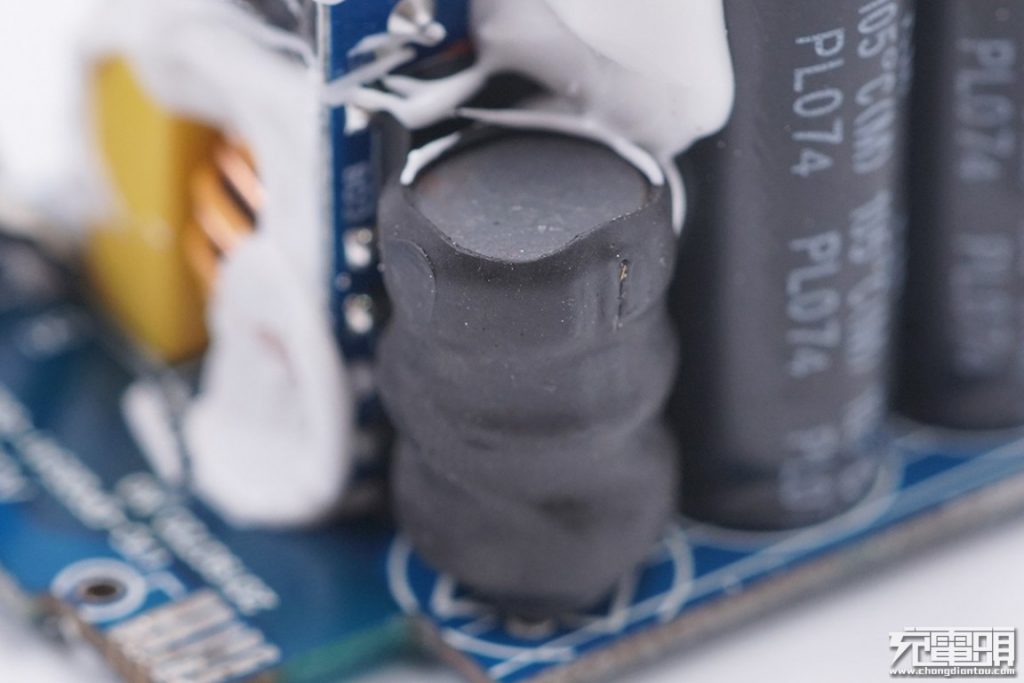
An input inductor.
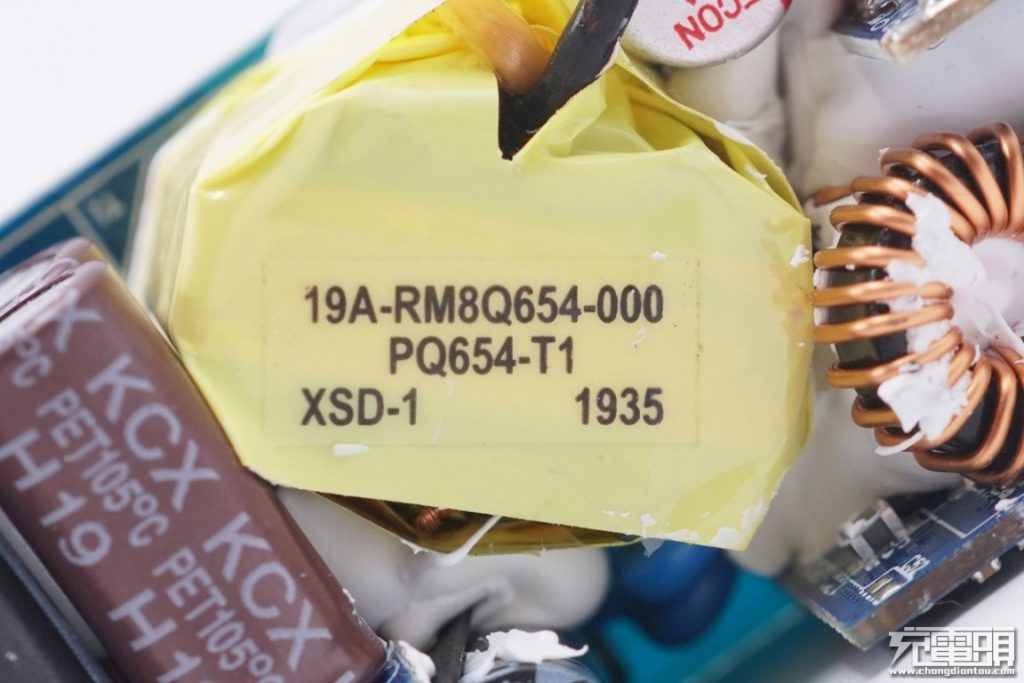
Close-up of the transformer.
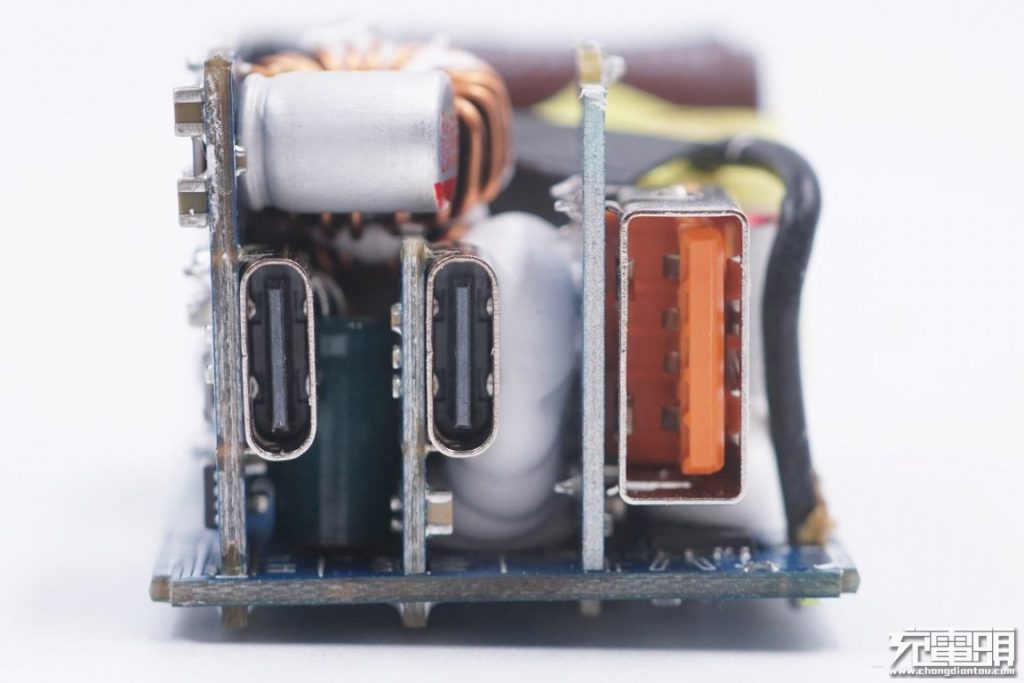
All three ports are mounted on their respective daughter boards. The daughter boards are mounted vertically onto the main PCB board.
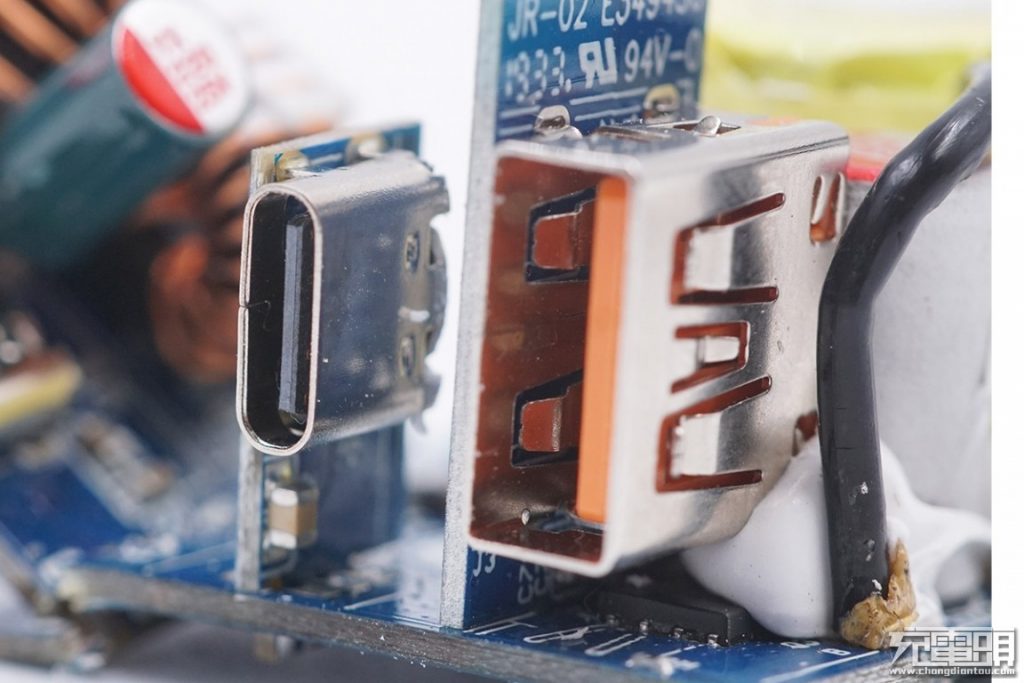
There is another secondary synchronous rectification MOSFET underneath the USB-A port.
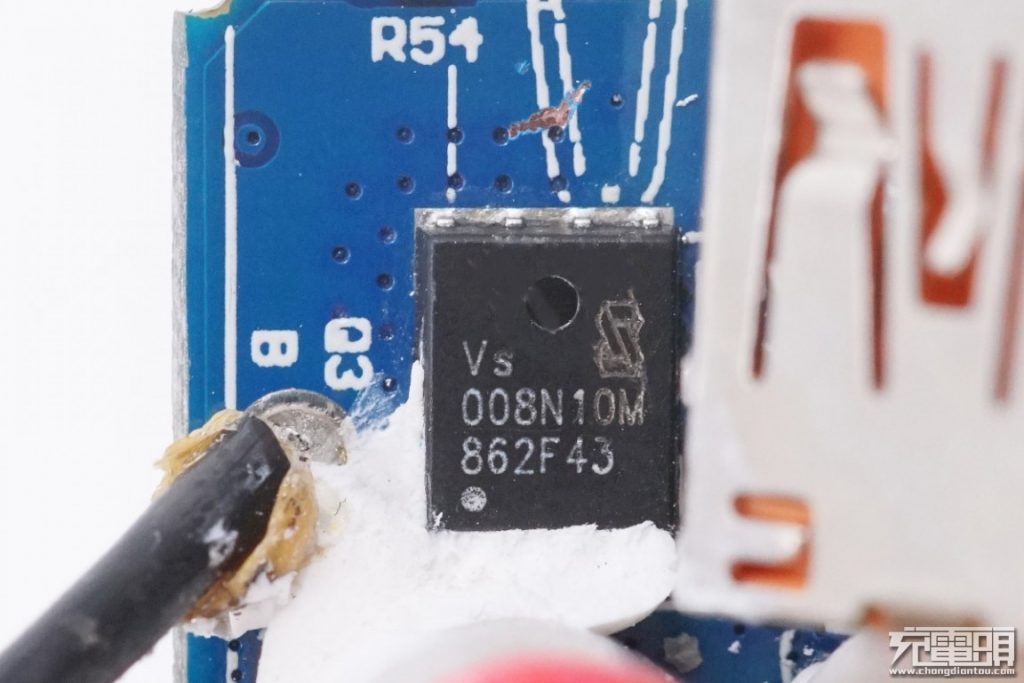
A Vanguard VSP008N10MS is used as the secondary synchronous rectification MOS, with 5V logic level control.
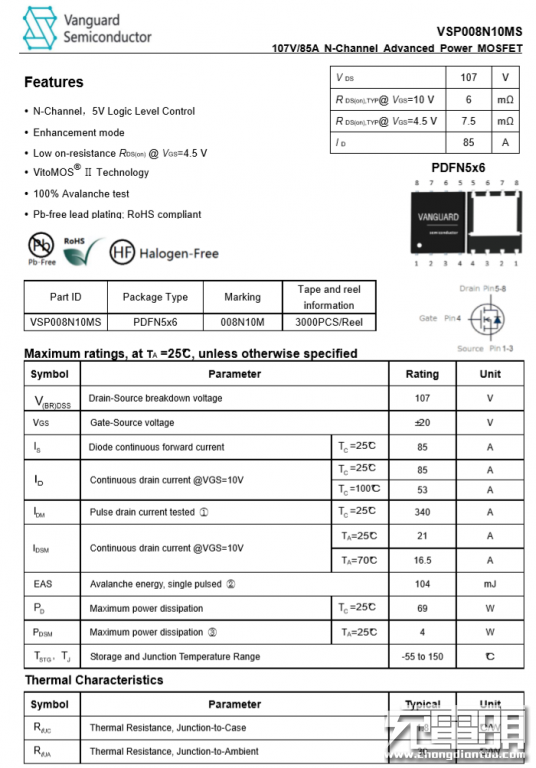
Detailed specifications of the Vanguard VSP008N10MS.
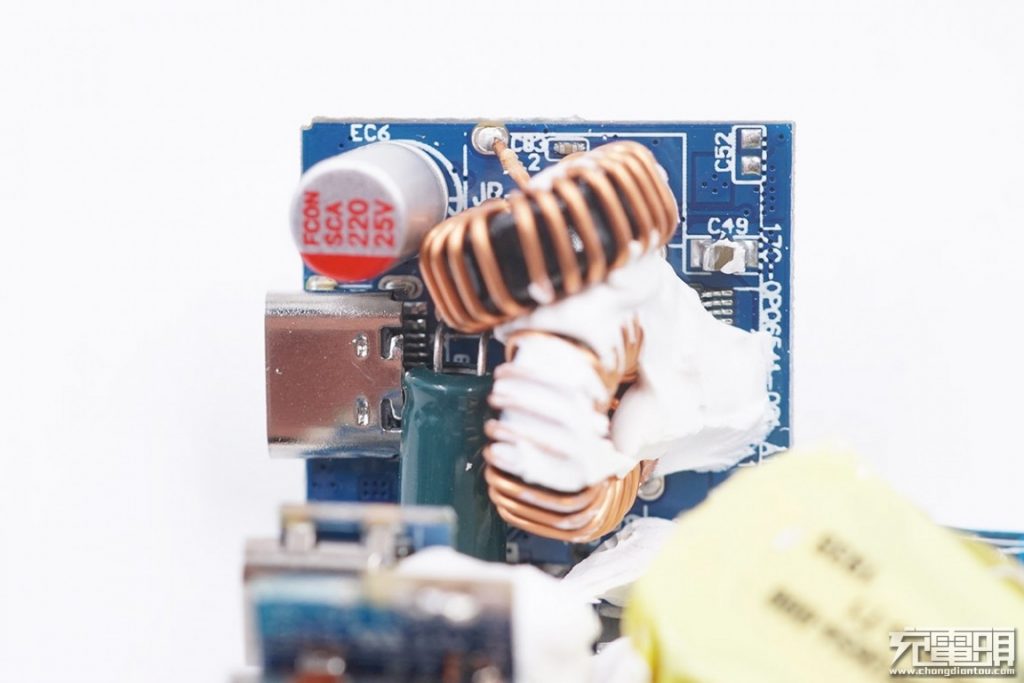
Two magnetic loop inductors are used for two-way buck output on the PCB for the second step-down. There are two solid capacitors for output filtering, and there is a chip is hidden underneath the inductor.
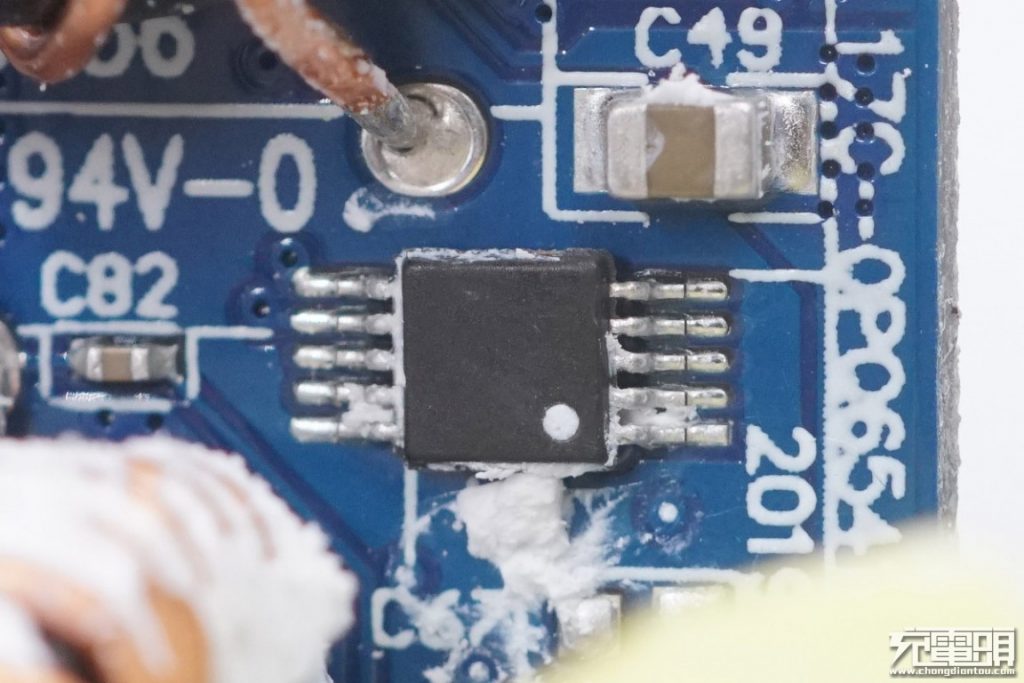
A chip with with no marking.
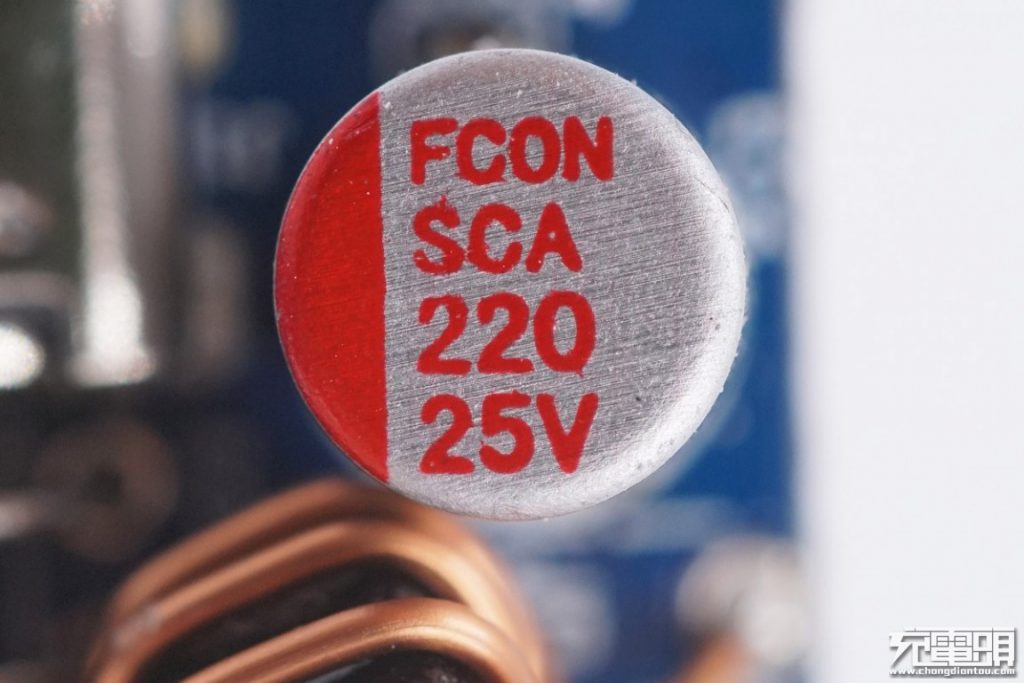
One of the solid capacitors is from FCON, with a specification of 220μF 25V.
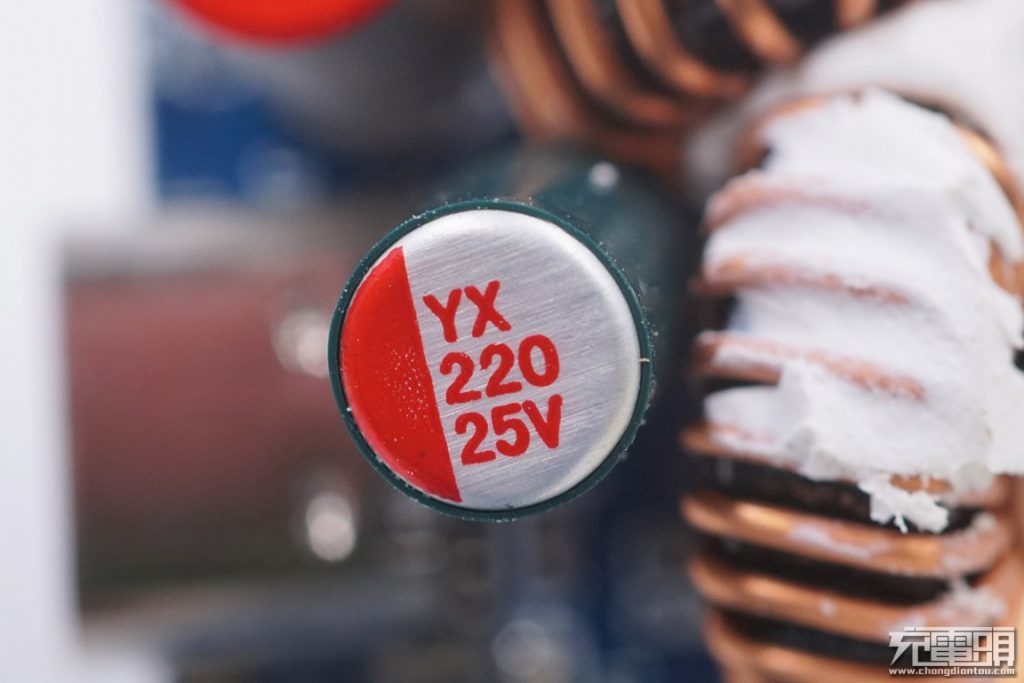
Another one is from Yunxing, with the same specification of 220μF 25V.
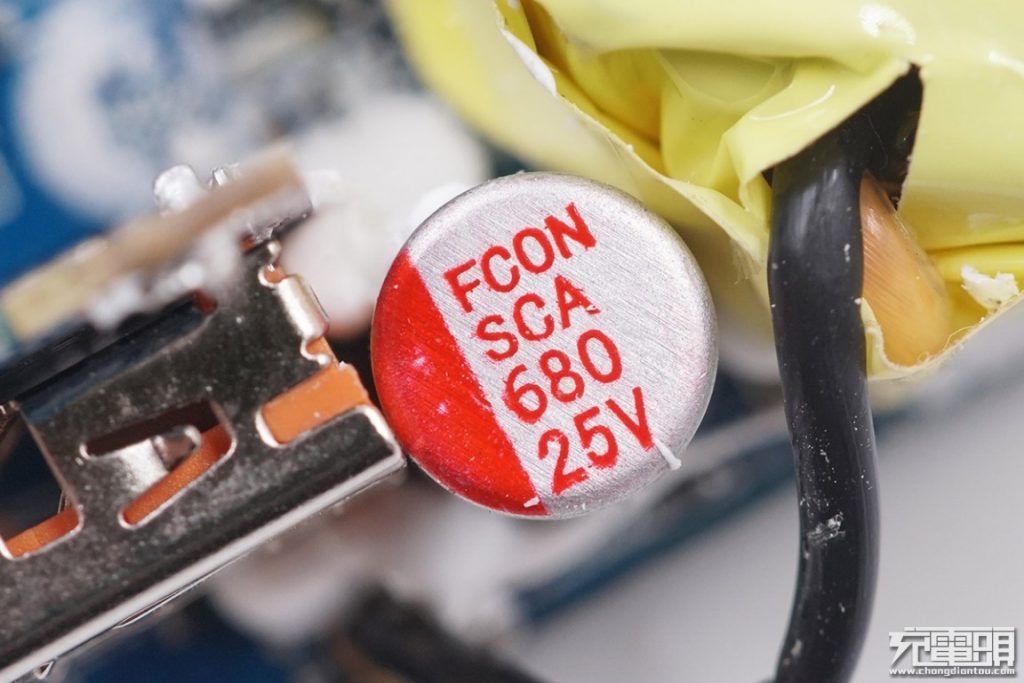
The solid capacitor next to the USB-A port comes from FCON, specification 680μF 25V, which acts as a secondary side secondary buck input filter.
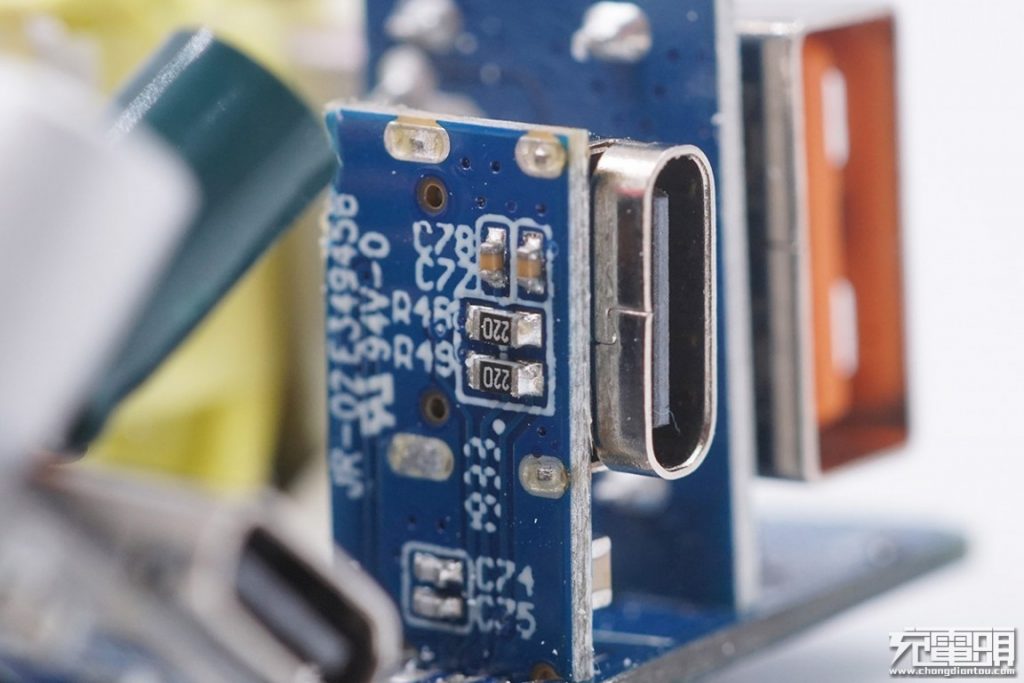
Close-up of the USB-C port.
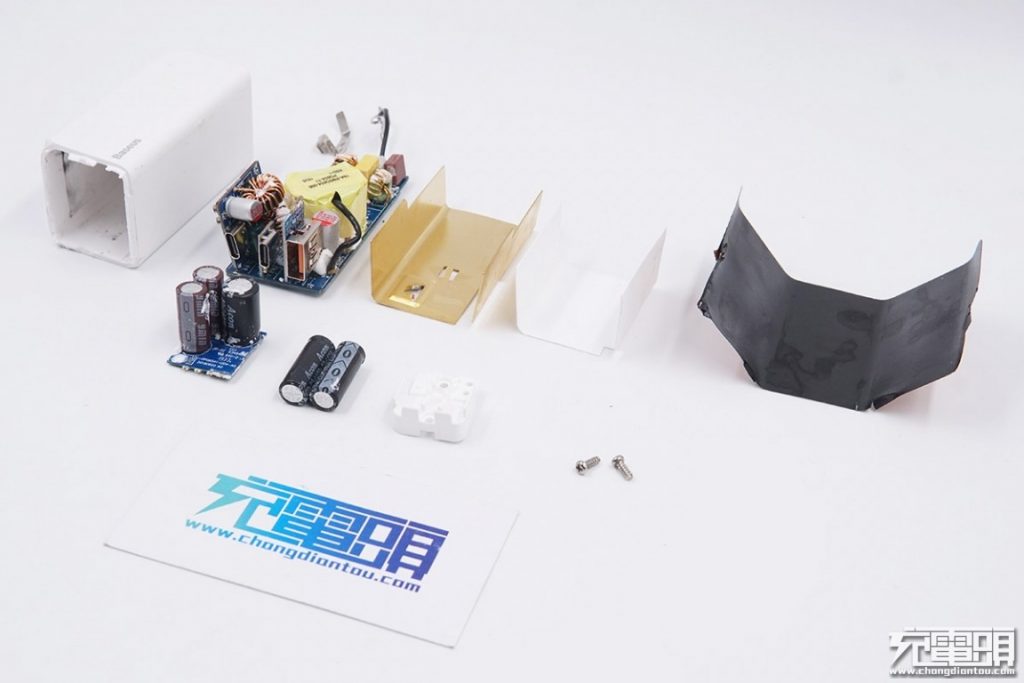
All the components.
IV Conclusion
It is no doubt that the Baseus 65W 2C1A multiport GaN charger has impressive specs, with three ports offering the best power split strategy to date, covering almost all charging protocols including PPS. It shows us how the next-gen multiport chargers will be: compact, powerful, smart.
On the inside, the charger is densely populated with some of the latest components including Navitas NV6115 GaN power IC, ON Semiconductor controller NCP1342, and iSmartWare SW3516H multiport protocol chip. However we find a few details that could use some optimization for better overall results.
Pros:
Powerful and compact with foldable prongs.
Good power split strategy.
Supports almost all charging protocols.
Cons:
A few details that could use some optimization.
Source: chongdiantou

